Lucy
Non-EO
NASA
Quick facts
Overview
| Mission type | Non-EO |
| Agency | NASA |
| Launch date | 16 Oct 2021 |
Lucy: NASA's mission to Jupiter's Trojans
Spacecraft Launch Mission Status Sensor Complement References
Jupiter's swarms of Trojan asteroids may be remnants of the primordial material that formed the outer planets, and serve as time capsules from the birth of our Solar System more than 4 billion years ago. The Trojans orbit in two loose groups that orbit the Sun, with one group always ahead of Jupiter in its path, the other always behind. At these two Lagrange points the bodies are stabilized by the Sun and Jupiter in a gravitational balancing act. 1) 2)
Lucy is a Discovery class mission led by principal investigator Harold "Hal" Levison from SwRI (Southwest Research Institute) in Boulder, Colorado, who, with a team of scientists and engineers, will address key science questions about the solar system. NASA's Goddard Space Flight Center in Greenbelt, Maryland, will provide overall mission management, systems engineering, and safety and mission assurance. Lockheed Martin Space Systems in Denver will build the spacecraft. Instruments will be provided by Goddard, the JHU/APL ( Johns Hopkins University/ Applied Physics Laboratory) in Laurel, Maryland, and Arizona State University. Discovery missions are overseen by the Planetary Missions Program Office at NASA's Marshall Space Flight Center in Huntsville, Alabama, for NASA's Planetary Science Division.
![Figure 1: During the course of its mission, Lucy will fly by six Jupiter Trojans. This time-lapsed animation shows the movements of the inner planets (Mercury, brown; Venus, white; Earth, blue; Mars, red), Jupiter (orange), and the two Trojan swarms (green) during the course of the Lucy mission [image credit: Astronomical Institute of CAS/Petr Scheirich (used with permission)]](https://www.eoportal.org/ftp/satellite-missions/l/Lucy_130622/LucyTrojans.gif)
These primitive bodies hold vital clues to deciphering the history of the solar system, and perhaps even the origins of life and organic material on Earth.
Lucy will be the first space mission to study the Trojans. The mission takes its name from the fossilized human ancestor (called "Lucy" by her discoverers) whose skeleton provided unique insight into humanity's evolution. Likewise, the Lucy mission will revolutionize our knowledge of planetary origins and the formation of the solar system.
Lucy will launch in October 2021 and, with boosts from Earth's gravity, will complete a 12-year journey to seven different asteroids — a Main Belt asteroid and six Trojans, the last two members of a "two-for-the-price-of-one" binary system. Lucy's complex path will take it to both clusters of Trojans and give us our first close-up view of all three major types of bodies in the swarms (so-called C-, P- and D-types).
The dark-red P- and D-type Trojans resemble those found in the Kuiper Belt of icy bodies that extends beyond the orbit of Neptune. The C-types are found mostly in the outer parts of the Main Belt of asteroids, between Mars and Jupiter. All of the Trojans are thought to be abundant in dark carbon compounds. Below an insulating blanket of dust, they are probably rich in water and other volatile substances.
No other space mission in history has been launched to as many different destinations in independent orbits around our sun. Lucy will show us, for the first time, the diversity of the primordial bodies that built the planets. Lucy's discoveries will open new insights into the origins of our Earth and ourselves.
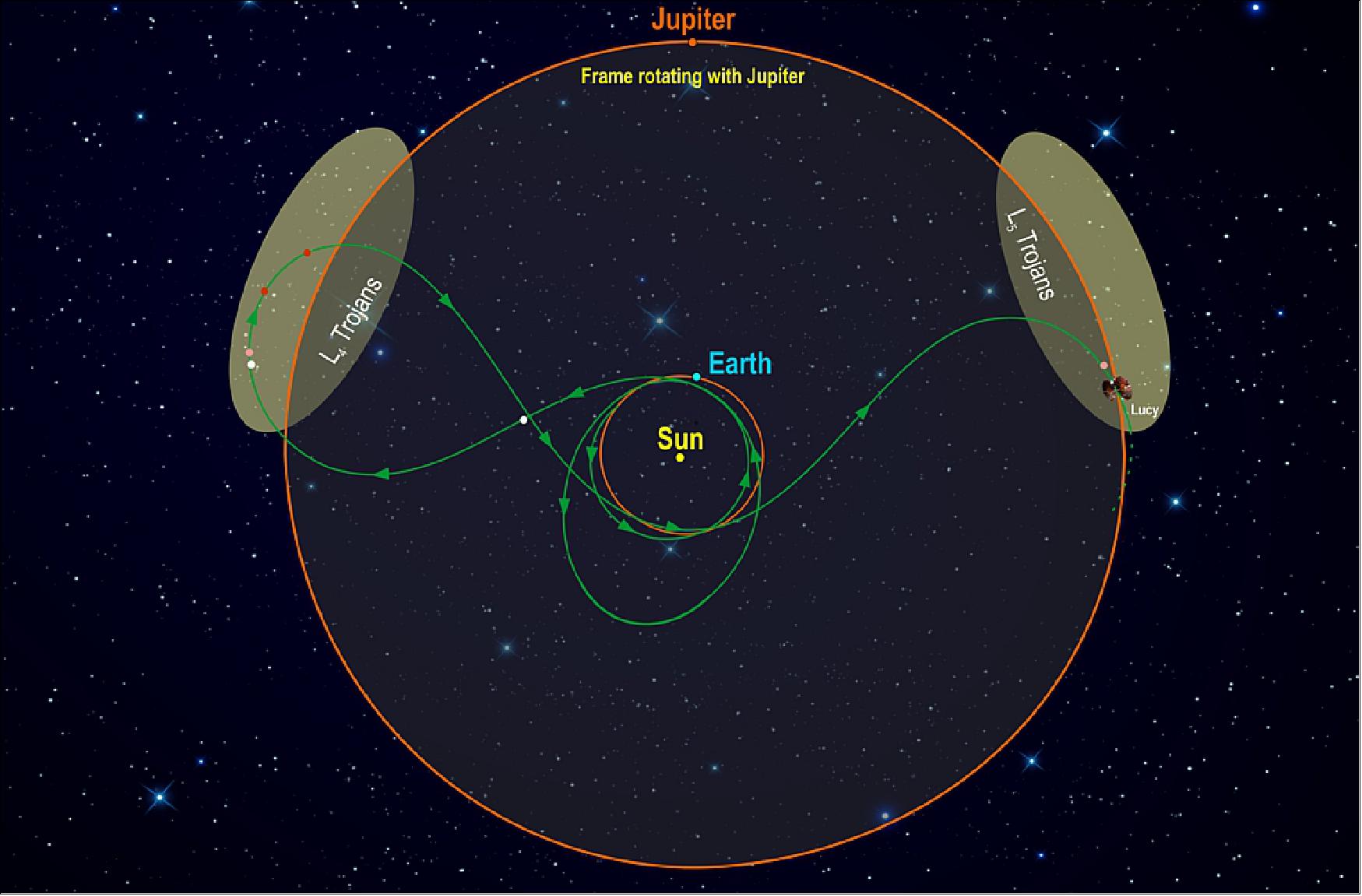
Some background: In January 2017, NASA selected a mission that will perform the first reconnaissance of the Trojans, a population of primitive asteroids orbiting in tandem with Jupiter. The Lucy mission will launch in 2021 to study six of these exciting worlds. 3)
"This is a unique opportunity," said Dr. Harold F. Levison, Lucy principal investigator from SwRI (Southwest Research Institute) in Boulder, Colorado. "Because the Trojans are remnants of the primordial material that formed the outer planets, they hold vital clues to deciphering the history of the solar system. Lucy, like the human fossil for which it is named, will revolutionize the understanding of our origins."
The Lucy spacecraft and a remote-sensing instrument suite will study the geology, surface composition, and bulk physical properties of these bodies at close range. The payload includes three complementary imaging and mapping instruments, including a color imaging and infrared mapping spectrometer from NASA's Goddard Space Flight Center in Greenbelt, Maryland, a high-resolution visible imager from the Johns Hopkins University Applied Physics Laboratory, Laurel, Maryland, and a thermal infrared spectrometer from Arizona State University, Tempe. In addition, Lucy will perform radio science investigations using its telecommunications system to determine the masses and densities of the Trojan targets.
"Understanding the causes of the differences between the Trojans will provide unique and critical knowledge of planetary origins, the source of volatiles and organics on the terrestrial planets, and the evolution of the planetary system as a whole," said Dr. Catherine Olkin, the mission's deputy principal investigator from SwRI.
"The Lucy mission is one of those rare moments where a single mission can have a major impact on our understanding of such fundamental questions," added Dr. Keith Noll, Lucy project scientist from Goddard.
SwRI in Boulder, Colorado is the principal investigator institution and will lead the science investigation. NASA's Goddard Space Flight Center, Greenbelt, Maryland will provide overall mission management, systems engineering, and safety and mission assurance. Lockheed Martin Space Systems in Denver, Colorado will build the spacecraft.
Discovery Program class missions like these are relatively low-cost, their development capped at about $450 million. They are managed for NASA's Planetary Science Division by the Planetary Missions Program Office at Marshall Space Flight Center in Huntsville, Alabama. The missions are designed and led by a principal investigator, who assembles a team of scientists and engineers, to address key science questions about the solar system.
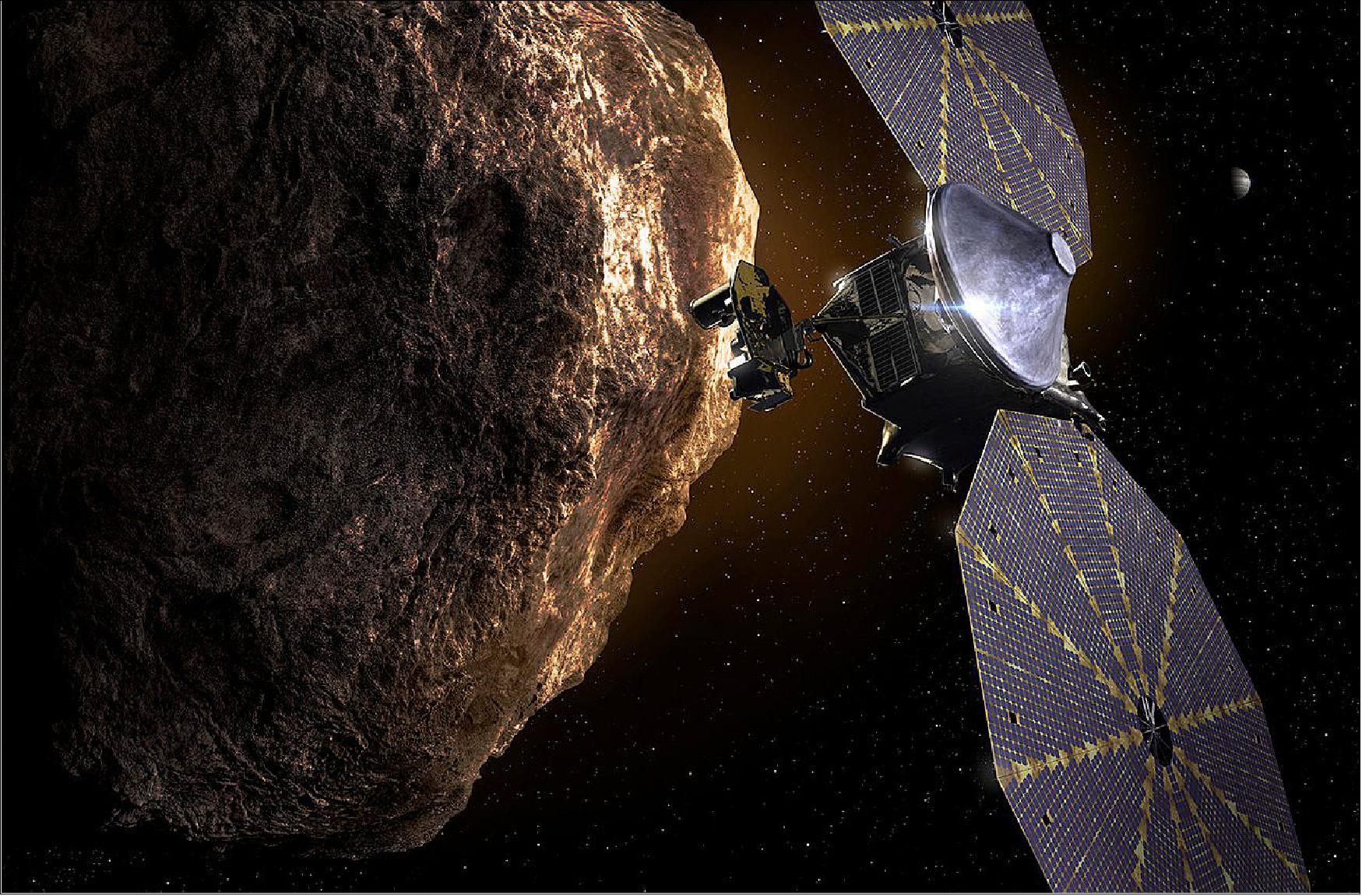
Spacecraft
The Lucy spacecraft will be over 13 m from tip to tip, but most of that is the huge solar panels (each over 6 meters) in diameter needed to power the spacecraft as it flies out to the orbit of Jupiter. All of the instruments, and the 2 m-high gain antenna needed to communicate with Earth, will be located on the much smaller spacecraft body. 4)

Some spacecraft parameters:
• Dry mass: 821 kg
• Wet mass: 1550 kg
• Power: 504 W at the furthest encounter
• Diameter of solar panels: 7.3 m (use of 2 solar panels)
Development Status
• October 15, 2021: Asteroids embody the story of our solar system's beginning. Jupiter's Trojan asteroids, which orbit the Sun on the same path as the gas giant, are no exception. The Trojans are thought to be left over from the objects that eventually formed our planets, and studying them might offer clues about how the solar system came to be. 5)
- Over the next 12 years, NASA's Lucy mission will visit eight asteroids — including seven Trojans — to help answer big questions about planet formation and the origins of our solar system. It will take the spacecraft about three and a half years to reach its first destination. What might Lucy find?
- Like all the planets, asteroids exist in the heliosphere, the vast bubble of space defined by the reaches of our Sun's wind. Directly and indirectly, the Sun affects many aspects of existence within this pocket of the universe. Here are a few of the ways the Sun influences asteroids like the Trojans in our solar system.
Place in Space
- The Sun makes up 99.8% of the solar system's mass and exerts a strong gravitational force as a result. In the case of the Trojan asteroids that Lucy will visit, their very location in space is dictated in part by the Sun's gravity. They are clustered at two Lagrange points. These are locations where the gravitational forces of two massive objects — in this case the Sun and Jupiter — are balanced in such a way that smaller objects like asteroids or satellites stay put relative to the larger bodies. The Trojans lead and follow Jupiter in its orbit by 60° at Lagrange points L4 and L5.
Pushing Asteroids Around (with Light!)
- That's right, sunlight can move asteroids! Like Earth and many other objects in space, asteroids rotate. At any given moment, the Sun-facing side of an asteroid absorbs sunlight while the dark side sheds energy as heat. When the heat escapes, it creates an infinitesimal amount of thrust, pushing the asteroid ever so slightly off its course. Over millions of years, this force, called the Yarkovsky effect, can noticeably alter the trajectory of smaller asteroids (those less than 25 miles, or about 40 km, in diameter).
- Similarly, sunlight can also alter the rotation rate of small asteroids. This effect, known as YORP (named for four scientists whose work contributed to the discovery), affects asteroids in different ways depending on their size, shape, and other characteristics. Sometimes, YORP causes small bodies to spin faster until they break apart. Other times, it may cause their rotation rates to slow.
- The Trojans are farther from the Sun than the near-Earth or Main Belt asteroids we've studied before, and it remains to be seen how the Yarkovsky effect and YORP affect them.
Shaping the Surface
- Just like rocks on Earth show signs of weathering, so too do rocks in space, including asteroids. When rocks warm up during the day, they expand. As they cool down, they contract. Over time, this fluctuation causes cracks to form. The process is called thermal fracturing. The phenomenon is more intense on objects without atmospheres, such as asteroids, where temperatures vary wildly. Therefore, even though the Trojans are farther from the Sun than rocks on Earth, they'll likely show more signs of thermal fracturing.
- The lack of atmosphere has another implication for asteroid weathering: Asteroids are battered by the solar wind, a steady stream of particles, magnetic fields, and radiation that flows from the Sun. For the most part, Earth's magnetic field protects us from this bombardment. Particles that do get through can excite molecules in Earth's atmosphere, resulting in auroras. Without magnetic fields or atmospheres of their own, asteroids receive the brunt of the solar wind. When incoming particles strike an asteroid, they can kick some material off into space, changing the fundamental chemistry of what's left behind.

• September 15, 2021: Discover the mysteries of the solar system through the eyes of the Lucy mission and its team members. This first episode features Deputy Principal Investigator Cathy Olkin, who discusses Lucy's journey out to explore the Trojan asteroids and what we hope to learn about our solar system. 6)
• August 2, 2021: NASA's Lucy spacecraft has officially arrived at Kennedy Space Center, Florida, to begin preparations ahead of its launch this fall. 7)
- "This spacecraft is so much more than a piece of hardware, it's a work of art, and I'm incredibly proud of how the team came together to build this through a global pandemic," said Rich Lipe, Lockheed Martin Lucy program manager. "To be here now, starting to prepare for launch, is a terrific feeling."
- Designed and built by Lockheed Martin for NASA, Lucy will give humankind its first ever close-up look at Jupiter's elusive Trojan asteroids. These celestial objects are important because scientists believe they could hold clues about how our solar system and the planets formed.
What's Ahead in the Journey?
- Following its pre-launch testing, launch vehicle integration and liftoff on an Atlas V 401 rocket, the path that lies ahead will see Lucy visit a record-breaking number of asteroids – eight, to be precise.
- As part of a highly complex orbital trajectory, Lucy will fly by one Main Belt asteroid and seven Trojan asteroids – ancient objects trapped within gravity wells created by the combined pull of Jupiter and the sun, near so-called Lagrange Points. One group leads and one group trails Jupiter in its orbit.
- The spacecraft will use precise instruments to study the geology, surface composition and physical properties of these primitive Trojan asteroids. Scientific theory hypothesizes these objects were scattered during the creation of our outer solar system roughly 4 billion years ago and later captured in Jupiter's orbit – remaining there, undisturbed, for billions of years.
- These genuine "fossils" of the solar system could hold clues about what conditions were like when the planets formed, leading to an even greater understanding of our own origins.
- Lucy's first asteroid flyby occurs in 2025, and the last planned flyby will be in 2033.
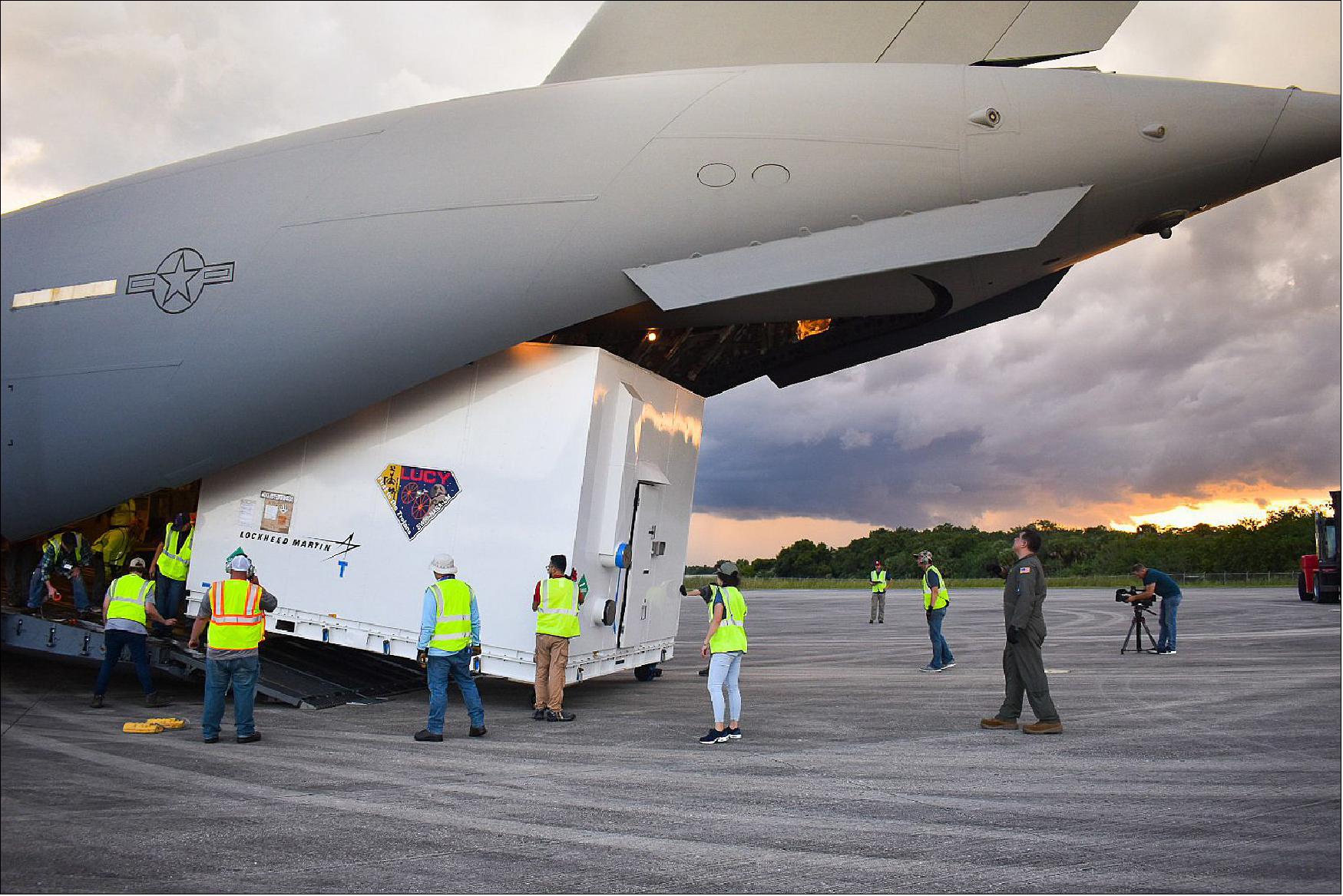
More About the Mission
- For more than 50 years, Lockheed Martin has helped NASA explore every planet in our solar system and continues to develop new technologies for future space missions like Lucy.
- Lucy is the seventh of 13 NASA Discovery-class missions in which Lockheed Martin has participated. The company will also build two NASA spacecraft headed to Venus at the end of the decade.
- Lockheed Martin Space designed, built, tested, and will operate Lucy out of its Littleton, Colorado, facility. NASA's Goddard Space Flight Center in Greenbelt, Maryland, provides overall mission management, systems engineering and safety and mission assurance. Southwest Research Institute in Boulder, Colorado, is the principal investigator institution and will operate the Science Operations Center (SOC). Marshall Space Flight Center in Huntsville, Alabama, manages the Discovery Program for the agency's Science Mission Directorate in Washington, D.C.
• July 12, 2021: In the 1970s four spacecraft began their one-way trips out of our Solar System. As the first human-built objects to ever venture into interstellar space, NASA chose to place plaques on Pioneer 10 and 11 and golden records on Voyager 1 and 2 spacecraft to serve as messages to any alien spacefarers that may someday encounter these spacecraft. Continuing this legacy, NASA's Lucy spacecraft will carry a similar plaque. However, because Lucy will not be venturing outside of our Solar System, Lucy's plaque is a time-capsule featuring messages to our descendants. 8)
- As the first-ever mission to the Trojan asteroids, Lucy will survey this enigmatic population of small bodies that orbit the Sun beyond the main asteroid belt - trapped by Jupiter and the Sun so that they have led and followed Jupiter in its orbit. As these never before explored asteroids are in many ways "fossils" from the formation and evolution of the planets, the Lucy spacecraft is named in honor of the fossilized human ancestor discovered the year after Pioneer 11 began its journey out of the Solar System. Lucy's name was inspired by the Beatles' song "Lucy in the Sky with Diamonds."
- After Lucy finishes visiting a record number of asteroids for a single mission in 2033 (8 asteroids on 6 independent orbits around the Sun) the Lucy spacecraft will continue to travel between the Trojan asteroids and the orbit of the Earth for at least hundreds of thousands, if not millions of years. It is easy to imagine that someday in the distant future our descendants will find Lucy floating among the planets. Therefore, the Lucy team chose to put a time-capsule aboard the Lucy spacecraft in the form of a plaque, messages this time not for unknown aliens, but for those that will come after us. The plaque was installed on the spacecraft in a ceremony at Lockheed Martin Space in Littleton, Colorado, on July 9, 2021.
- This time-capsule contains messages from prominent members of our society; individuals who have asked us to contemplate the state of the human condition as well as our place in the universe. These thoughtful leaders were asked to provide words of advice, words of wisdom, words of joy, and words of inspiration to those who may read this plaque in the distant future. These messages were solicited from Nobel Laureates in Literature, United States Poet Laureates, and other inspirational figures including the members of the band that indirectly inspired the Lucy mission's name.
- To date this time-capsule, the plaque also includes a depiction of the Solar System on the day of Lucy's anticipated launch of October 16, 2021. The original trajectory of the Lucy spacecraft, traveling between the Trojan swarms and the Earth's orbit, is shown as well.
- NASA places this plaque with the hope that space exploration continues and someday astro-archeologists may travel among the planets and retrieve this spacecraft as an artifact of the early days when humanity took its first steps to explore our Solar System.
- Southwest Research Institute in Boulder, Colorado is the principal investigator institution. NASA's Goddard Space Flight Center in Greenbelt, Maryland provides overall mission management, systems engineering and safety and mission assurance. Lockheed Martin Space in Littleton, Colorado is building the spacecraft. Lucy is the 13th mission in NASA's Discovery Program. NASA's Marshall Space Flight Center in Huntsville, Alabama, manages the Discovery Program for the agency's Science Mission Directorate in Washington, D.C.
• June 1, 2021: NASA's Lucy in the Cleanroom. 9)
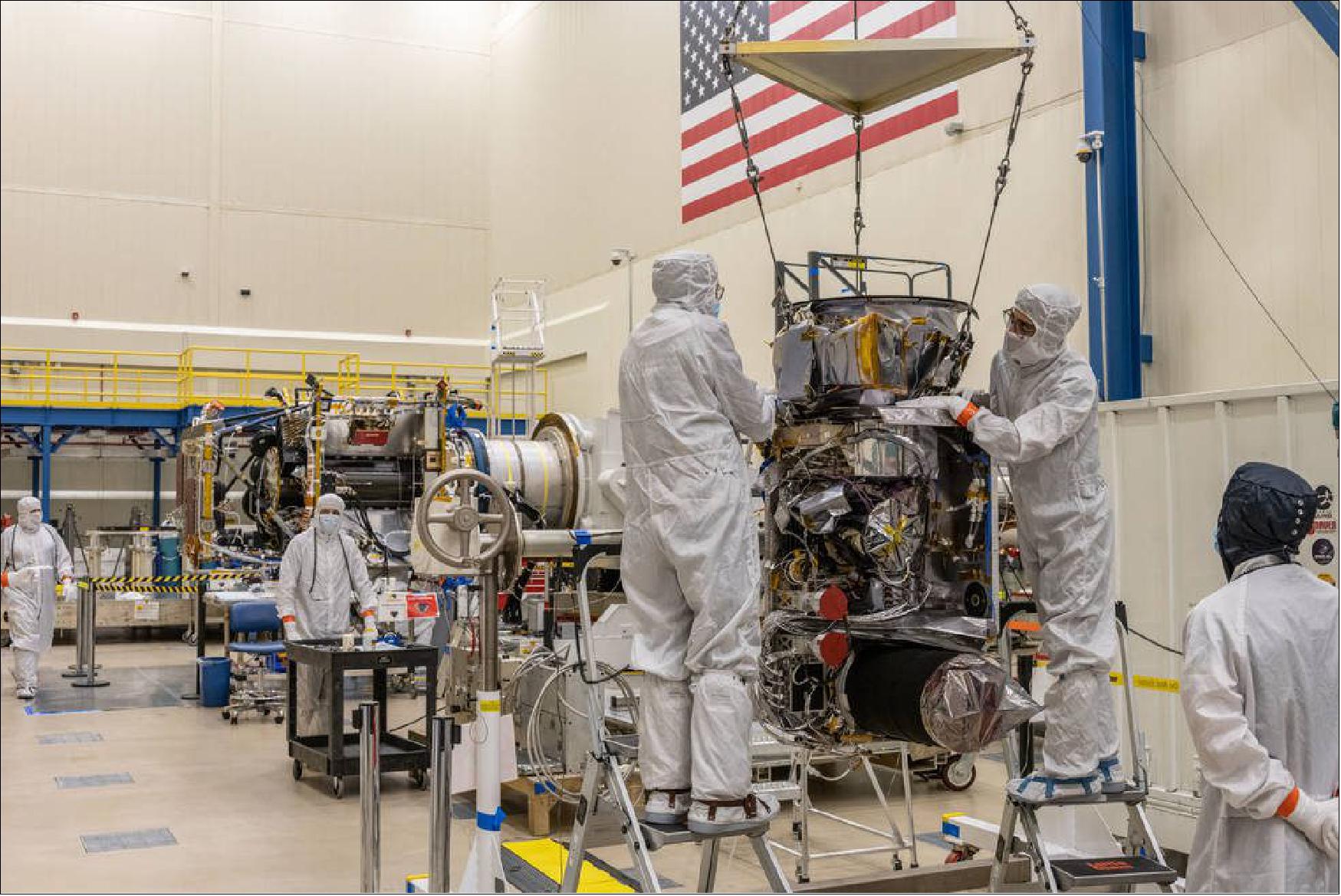
• April 20, 2021: NASA's Lucy Mission Extends its Solar Arrays. 10)
• April 19, 2021: On Jan. 9, 2020, NASA's Lucy mission officially announced that it would be visiting not seven, but eight asteroids. As it turns out, Eurybates, one of the asteroids along Lucy's path, has a small satellite. 11)
- Though searching for satellites is one of the mission's central goals, finding these tiny worlds before Lucy is launched gives the team the opportunity to investigate their orbits and plan for more detailed follow-up observations with the spacecraft. Without searching for these asteroid companions before launch, Lucy could also run the risk of encountering an unexpected binary pair. Seeing two asteroids when the spacecraft is expecting only one could confuse its autonomous tracking system.
- Fortunately, the Lucy science team is already familiar with the perfect tool to use. "One of the ways that you can try to look for satellites is to use Hubble. And that's something that I've done a lot with the Kuiper Belt," says Keith Noll, the mission's project scientist at NASA's Goddard Space Flight Center in Greenbelt, Maryland, and one of the discoverers of Eurybates' satellite. "We know more than 100 binaries in the Kuiper Belt, and the vast majority of those were found with Hubble."
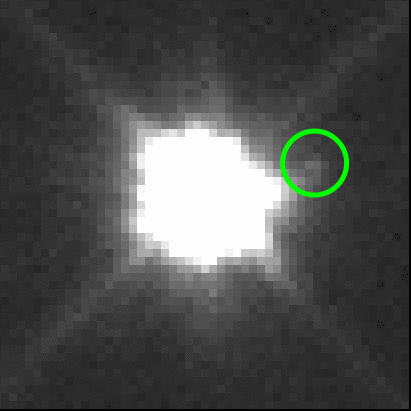
- And understandably so. The orbiting telescope, 13.3 meters long, which has a primary mirror with a diameter of 2.4 meters, is unencumbered by the normal blurring effects of Earth's atmosphere, since it resides comfortably above the atmosphere. Though some of the larger earthbound telescopes are sometimes able to observe the heavens with similar clarity, Hubble can detect a small, dim satellite orbiting very close to a larger, brighter asteroid that a telescope on Earth might miss.
- To know where to look for satellites, the science team had to calculate the Hill spheres of the asteroids they wanted to examine. The Hill sphere is an imaginary sphere around a body, inside of which the body has the dominant gravitational influence. In other words, all stable satellites of a body orbit within its Hill sphere. Earth's Hill sphere, for instance, has a radius of nearly 1.5 million km (930,000 miles), and the Moon orbits safely inside at approximately 380,000 km (236,000 miles).
- Noll's team submitted a proposal to use Hubble to search for satellites and made their first round of observations in the fall of 2018. They then scoured the images for evidence of satellites. This process is difficult, since raw images from Hubble can be messy. "It's got a lot of bumps and blobs, it's not a clean thing," remarks Noll. For instance, raw images of bright objects often show diffraction spikes, the bright X-shapes that resemble cartoon four-pointed stars. Hubble's cameras are also susceptible to cosmic rays (particles traveling at close to the speed of light) which can appear as bright dots on the images. "So when you look at [the images], you say, ‘Well, is that blob a satellite, or is it just part of… the way that the light gets scattered from the entire optical assembly throughout the telescope?'" Except for a brief false alarm when it appeared that another Lucy target, Orus, might be a binary, the team saw no new evidence of satellites.
- That is, until November 2019. The night before a large science team meeting, Noll was preparing a presentation on searching for satellites. In looking for photos to demonstrate the difficulties of distinguishing between satellites and other bright blobs, he came across one of his team's Hubble photos from Sept. 12, 2018. After experimenting with the brightness and contrast, he saw one peculiar bright spot near Eurybates. "I said, ‘Gosh, that one really looks like what I would expect a satellite to look like.'" Realizing it was getting late, he circled the object and finished making the presentation. In his talk the next day, he pointed out the object's striking resemblance to a satellite. In the audience was Mike Brown, one of the mission's science co-investigators. Brown interrupted to ask Noll if he had looked at the data from the other observation on Sept. 14, but Noll admitted that he had not had a chance yet. According to Noll, before he finished presenting, Brown examined the data from Sept. 14 and exclaimed, "I see it there too!"
- Everyone crowded around Brown's laptop. Had they actually discovered a satellite of Eurybates? The team noticed that as they compared the two photos, the object appeared to have moved a little, like a satellite might. A check revealed that the object's observed positions fit many possible orbits. From a planetary dynamics perspective, it also made sense that Eurybates might have a satellite. Eurybates is one of a massive set of fragments created by the same asteroid collision, so the idea that one of these fragments might be orbiting Eurybates is not far-fetched. These were all steps in the right direction, but not conclusive evidence. The team had only two observations so far, and according to Noll, "You never really believe anything until you've seen it the third time, so we had to get more data." They submitted an urgent proposal to use Hubble again, which was approved quickly enough that the team was able to get their observations about a month later. They requested 12 chances to observe the satellite, but they were granted three. If they could see the satellite again on at least one of the three, they would be given the other nine.
- Their first chance was on Dec. 11. The satellite was a no-show. The team wasn't worried – yet – because they knew there was a good chance that it might be simply too close to Eurybates, and lost in the glare. They tried a second time on Dec. 21, but much to their consternation, the shy little rock was nowhere to be found. The team began to doubt that their so-called satellite even existed. "Maybe we're just kidding ourselves. Maybe it's not real," Noll remembers thinking.
- Finally, on Jan. 3, they found it. The tiny, dim satellite was clearly visible on the new images. As they'd suspected, in the previous two observations it was too close to Eurybates (which is over 6,000 times brighter than its companion) to be seen. The difference in brightness suggests that the satellite is probably less than 1 km in diameter, puny compared to Eurybates (64 km).
- Shortly after the Lucy team discovered the satellite, both it and Eurybates moved behind the Sun, preventing the team from observing it further. However, the asteroids emerged from behind the Sun in July 2020, and since then, the Lucy team has been able to observe the satellite with Hubble on multiple occasions, allowing the team to precisely define the satellite's orbit and allowing the little satellite to finally get an official name – Queta.
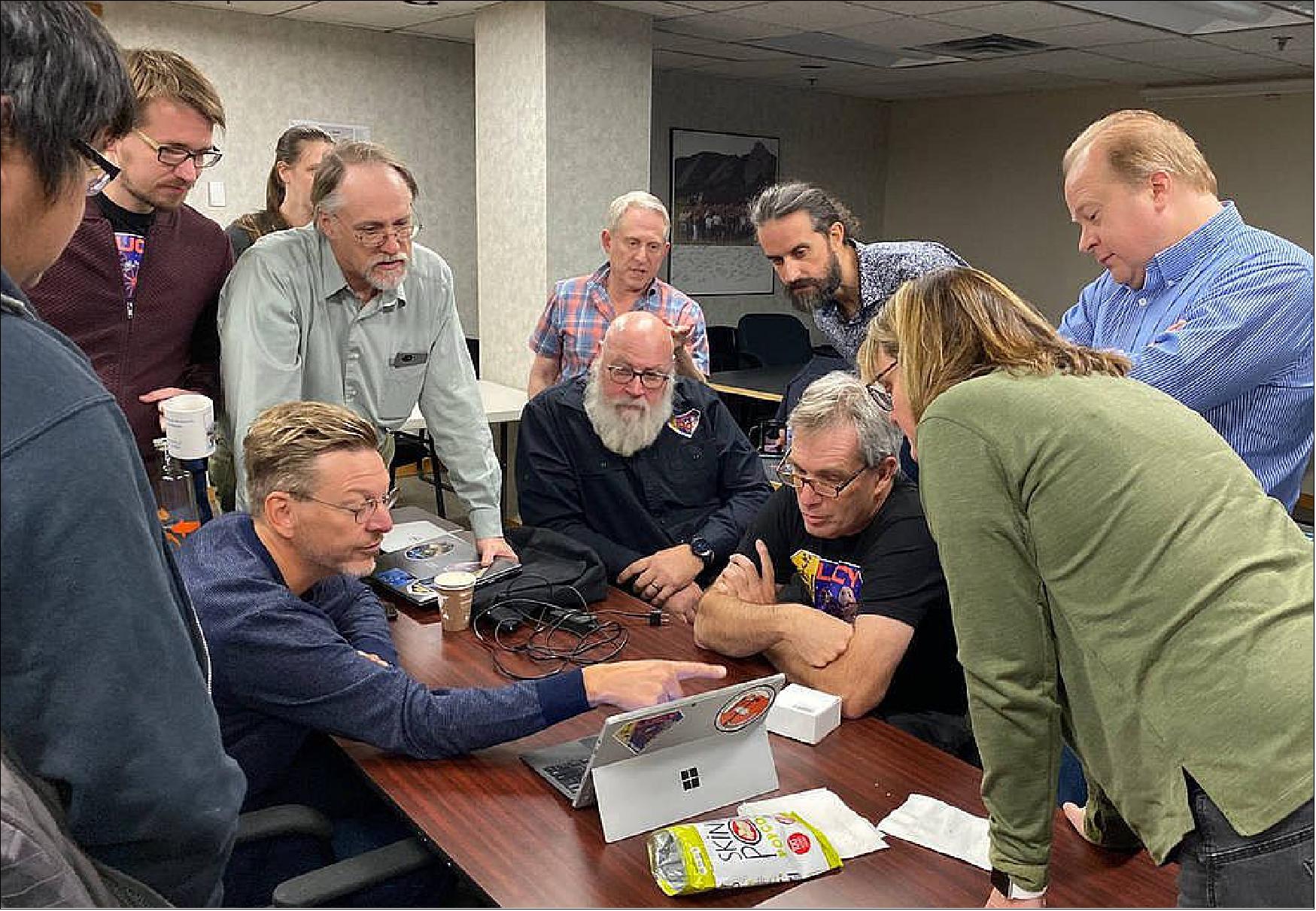
- Queta is the first Trojan asteroid named under a newly revised naming convention for Trojan asteroids. Though the Trojans were previously only named for heroes from Homer's Iliad, smaller Trojans are now named after Olympic and Paralympic athletes, in recognition of these modern day heroes. Queta is named in honor of Mexican track and field athlete Norma Enriqueta "Queta" Basilio Sotelo. At the 1968 Summer Olympics, she became the first woman in history to light the Olympic cauldron. The name "Queta" was selected for Eurybates' satellite because Basilio's role is similar to that of Eurybates, a Greek herald. In ancient Greece, heralds were messengers in the service of kings or governments, an occupation that sometimes involved running long distances. According to the ancient Greek historian Herodotus, a herald named Pheidippides ran 260 km from Athens to Sparta to request the Spartans' aid in the Battle of Marathon. (It is from this legend that we get the word "marathon.") Heralds were also tasked with announcing the start of the ancient Olympic Games, similar to how the torch ceremony announces the start of the modern Olympic Games. Though the torch ceremony was not a part of the ancient Olympics, it is inspired by an ancient Greek tradition called the lampadedromia, a relay race in which the runners pass a torch while trying to keep its sacred fire burning. Several other members of the Eurybates family, a group of asteroids that are actually fragments formed by the same collision, have been named after heroes of the 1968 Olympic and Paralympic Games. As a fellow trailblazer of the 1968 Games, Queta fits right in.
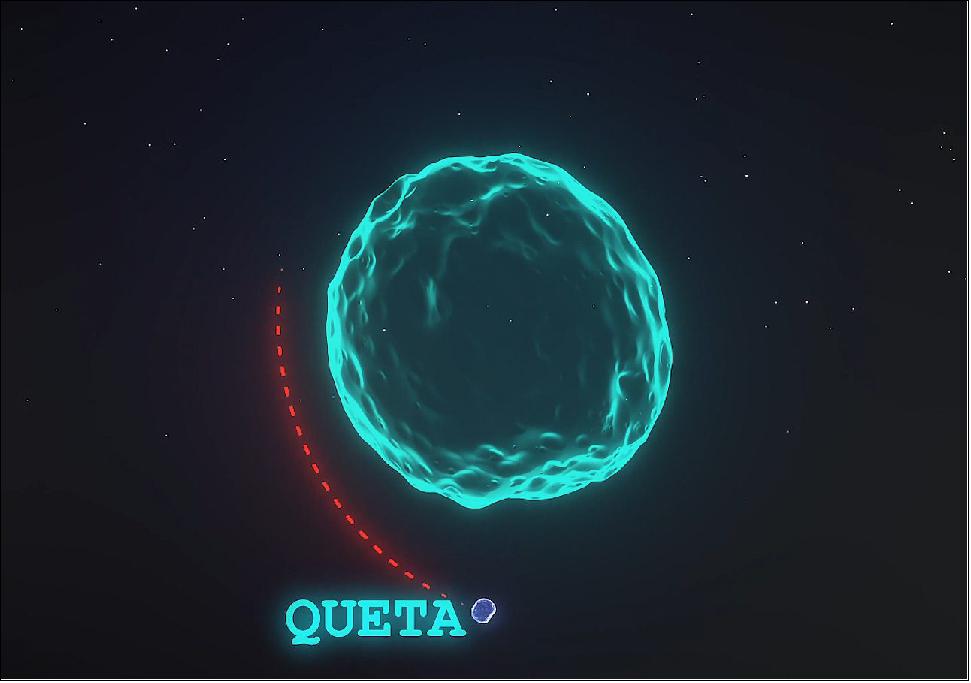
• February 9, 2021: With less than a year to launch, NASA's Lucy mission's third and final scientific instrument has been integrated onto the spacecraft. 12)
- The spacecraft, which will be the first to explore the Trojan asteroids — a population of small bodies that share an orbit with Jupiter — is in the final stages of the assembly process. Just five months ago, at the beginning of the Assembly, Testing and Launch operations (ATLO) process, the components of the Lucy spacecraft were being built all over the country. Today, a nearly assembled spacecraft sits in the high bay in Lockheed Martin Space in Littleton, Colorado.
- "A bit over a year and a half ago, I was excited to hold the first small pieces of metal that were destined to travel to the Trojan asteroids," says Hal Levison, principal investigator from the Southwest Research Institute. "Now there is an actual spacecraft, nearly ready to go. It is incredible."
- The final instrument, L'Ralph, was built by NASA's Goddard Space Center in Greenbelt, Maryland, and was received at Lockheed Martin on January 21 and integrated on to the spacecraft on January 26. L'Ralph is the most complicated instrument that will fly on Lucy, as it is actually two instruments in one. The Multispectral Visible Imaging Camera (MVIC), will take visible light color images of the Trojan asteroids. The Linear Etalon Imaging Spectral Array (LEISA), will collect infrared spectra of the asteroids. Both of these components will work together to allow Lucy to determine the composition of the Trojan asteroids and provide insight into the early history of our solar system.
- The L'Ralph instrument experienced significant COVID-19 related delays, particularly when construction had to be halted when Goddard was placed under stage 4 COVID restrictions in April of last year. However, both the L'Ralph team at Goddard and the ATLO team at Lockheed Martin rose to the challenge and developed a new schedule that allowed everyone to work safely while keeping the spacecraft on track for its originally planned October 16, 2021 launch.
- "The L'Ralph team has done an outstanding job to deliver a fantastic instrument," says Dennis Reuter, L'Ralph instrument principal investigator, from Goddard. "Doing what they did under normal conditions would have been remarkable. Doing it under the actual conditions that had to be dealt with is amazing."
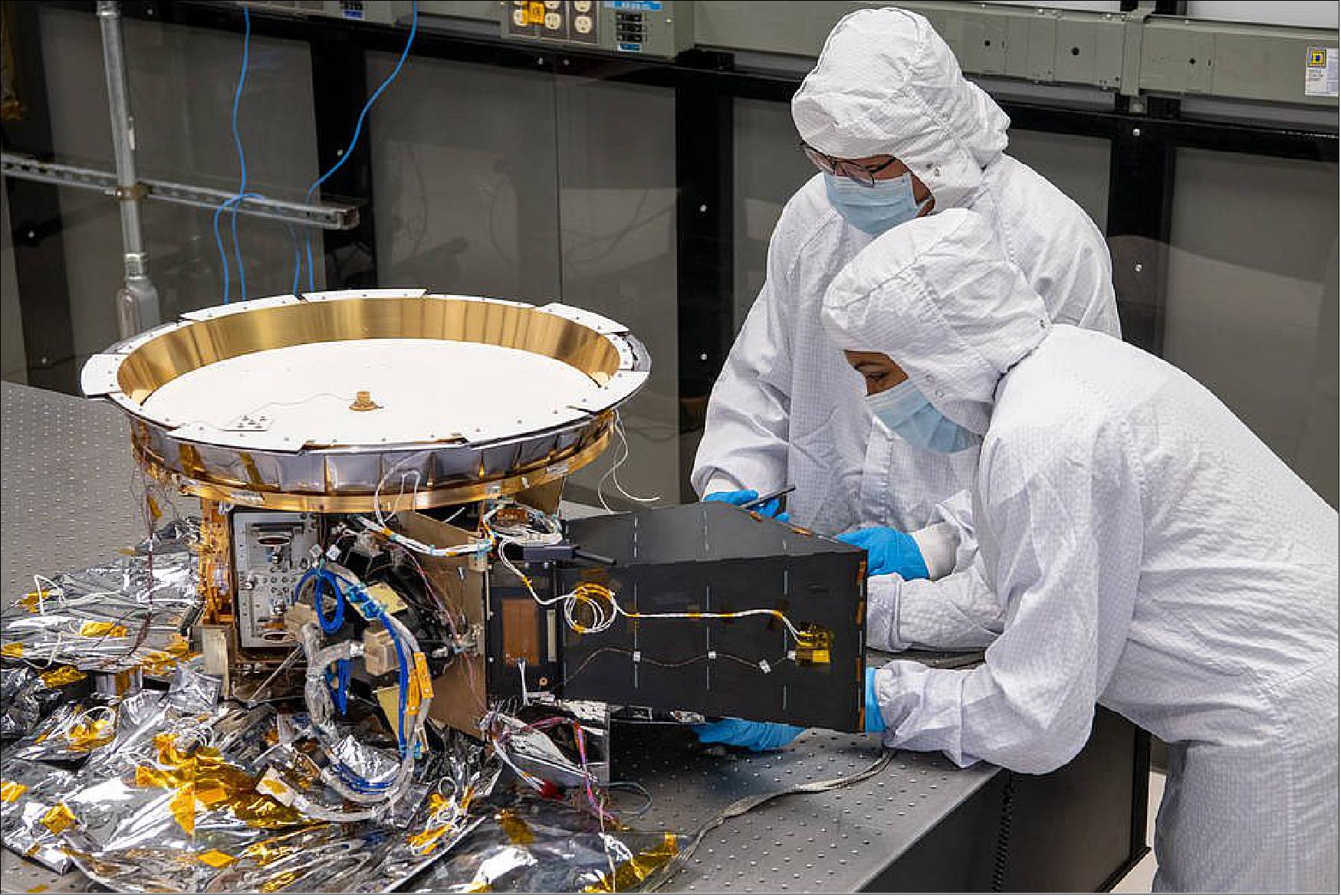
- L'Ralph has been installed on Lucy's Instrument Pointing Platform. This platform provides the spacecraft significant flexibility during the encounters — the instruments can point at the Trojan asteroids during the high-speed flybys while the high gain antenna remains pointed at Earth — as well as carrying out fine adjustments and out-of-plane pointing to get the best data possible on these elusive objects.
- Lucy's other two scientific instruments, L'TES and L'LORRI, designed and built at Arizona State University, and Johns Hopkins Applied Physics Laboratory, respectively, as well as the two Terminal Tracking Cameras have already been installed on the platform. Now that L'Ralph is installed, the platform itself will be installed onto the spacecraft bus — making Lucy one step closer to ready for her 12-year-long journey to the Trojans.
- "Lucy ATLO has been tremendously successful and having L'Ralph delivered and integrated onto the Instrument Pointing Platform is a great start to the new year," said Donya Douglas-Bradshaw, mission project manager from Goddard.
- Southwest Research Institute's Hal Levison and Cathy Olkin are the principal investigator and deputy principal investigator of the Lucy Mission. Goddard provides overall mission management, systems engineering and safety and mission assurance. Lockheed Martin Space is building the spacecraft. Lucy is the 13th mission in NASA's Discovery Program. NASA's Marshall Space Flight Center in Huntsville, Alabama, manages the Discovery Program for the agency's Science Mission Directorate in Washington, D.C.
• January 5, 2021: In addition to L'TES, Lucy's High Gain Antenna, which will enable spacecraft communication with the Earth for navigation and data collection, as well as precise measurement of the masses of the Trojan asteroids, was recently installed. It joined L'LORRI, Lucy's highest resolution camera, built by the Johns Hopkins Applied Physics Laboratory, which was installed in early November. Lucy's remaining scientific instrument, L'Ralph, the mission's color imaging camera and infrared spectrometer, is scheduled to be delivered in early 2021 (Ref. 28).
- Southwest Research Institute's Hal Levison and Cathy Olkin are the principal investigator and deputy principal investigator of the Lucy Mission. NASA's Goddard Space Flight Center provides overall mission management, systems engineering and safety and mission assurance. Lockheed Martin Space is building the spacecraft. Lucy is the 13th mission in NASA's Discovery Program. NASA's Marshall Space Flight Center in Huntsville, Alabama, manages the Discovery Program for the agency's Science Mission Directorate in Washington, D.C.
• August 28, 2020: NASA's first mission to explore the Trojan asteroids is one step closer to launch. The Discovery Program's Lucy mission passed a critical milestone and is officially authorized to transition to its next phase. 13)
- NASA's first mission to explore the Trojan asteroids is one step closer to launch. The Discovery Program's Lucy mission passed a critical milestone and is officially authorized to transition to its next phase.
- This major decision was made after a series of independent reviews of the status of the spacecraft, instruments, schedule and budget. The milestone, known as Key Decision Point-D (KDP-D), represents the official transition from the mission's development stage to delivery of components, testing, assembly and integration leading to launch. During this part of the mission's life cycle, known as Phase D, the spacecraft bus (the structure that will carry the science instruments) is completed, the instruments are integrated into the spacecraft and tested, and the spacecraft is shipped to NASA's Kennedy Space Center in Florida for integration with the launch vehicle.
- "Each phase of the mission is more exciting than the last," says Lucy Principal Investigator Hal Levison of Southwest Research Institute in Boulder, CO. "While, of course, Lucy still has several years and a few billion miles to go before we reach our real goal – exploring the never-before-seen Trojan asteroids – seeing this spacecraft come together is just incredible."
- Assembly, Testing and Launch Operations (ATLO) began on schedule last week at Lockheed Martin Space in Littleton, Colorado, despite many unforeseen challenges related to the coronavirus pandemic. The schedule was revised to allow for later integration of components that were delayed due to COVID-19 restrictions.
- "This team has been truly incredible," says Lucy Project Manager Donya Douglas-Bradshaw, from NASA's Goddard Space Flight Center in Greenbelt, Maryland. "Building a spacecraft is never easy, but seeing the team persevere through all of the challenges that they have encountered is inspiring. We now have a spacecraft structure in the Lockheed Martin high bay and a team ready to install the instruments and components."
- The oxidizer tank has already been integrated with the spacecraft, and the instrument integration starts in October. All spacecraft assembly and testing will be completed by the end of July 2021, when the spacecraft will be shipped to Kennedy Space Center in Cape Canaveral, Florida in preparation for the launch window opening on October 16, 2021. After launch, Lucy will have a long cruise phase before it arrives at its first target. Lucy is flying out to the distance of Jupiter to make close fly-bys past a record-breaking number of asteroids, encountering the first of eight targets in April 2025 and the final binary pair of asteroids in March 2033.
- The next major milestone is the Mission Operation Review, scheduled in October 2020, which assesses the project's operational readiness and its progress towards launch.
- Southwest Research Institute in Boulder, Colorado, is the principal investigator institution for Lucy. NASA Goddard Space Flight Center in Greenbelt, Maryland provides overall mission management, systems engineering, and safety and mission assurance. Lockheed Martin Space near Denver is building the spacecraft and will perform spacecraft flight operations. Instruments will be provided by Goddard, the Johns Hopkins Applied Physics Laboratory in Laurel, Maryland, and Arizona State University.
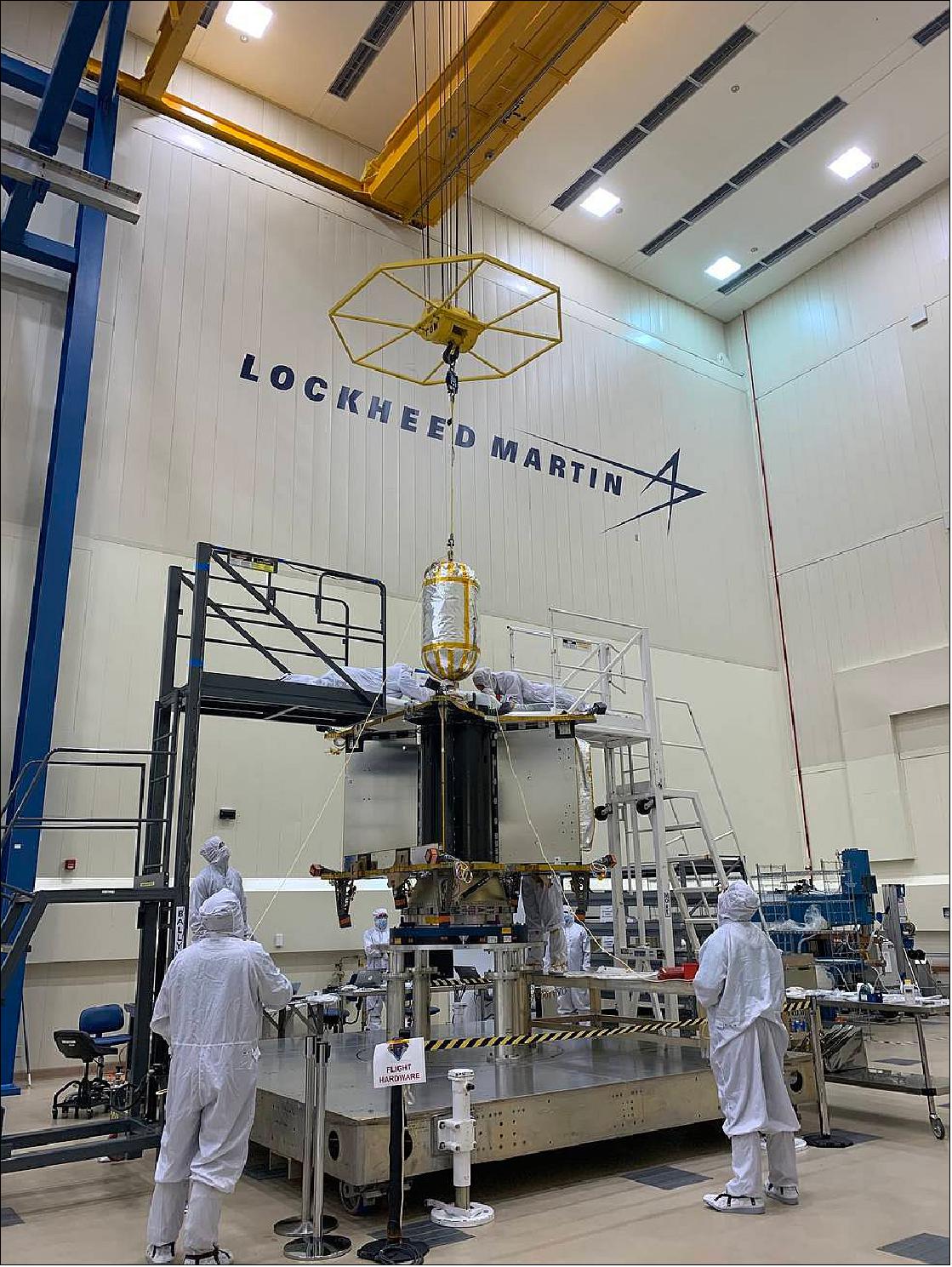
• August 3, 2020: Last week marked the completion of a major milestone on the path to spacecraft assembly, test, and launch operations for NASA's Lucy mission. 14)
- The Systems Integration Review ensured segments, components, and subsystems, scientific instrumentation, electrical and communication systems, and navigation systems are on schedule to be integrated into the system. It confirmed that facilities, support personnel, and plans and procedures are on schedule to support integration.
- The four-day meeting took place from July 27-30. On July 31, the standing review board briefed the team on the results. Due to Covid-19, the review occurred virtually.
- In order to keep the team safe during the pandemic, NASA and the partner institutions delayed construction on some of the instruments and components. The Lucy assembly, test and launch operations (ATLO) team developed a new schedule to allow the team to reorder the assembly and testing timeline to give components and subsystems the flexibility they need and still get the spacecraft ready for an on-schedule launch in October 2021.
- "No one anticipated that we would be building a spacecraft under these circumstances," said Lucy Principal Investigator, Hal Levison, "but I once again have been impressed by this team's creativity and resiliency to overcome any challenge placed before them."
- Successful completion of this System Integration Review means that the project can proceed with assembling and testing the spacecraft in preparations for launch. The spacecraft is on track to begin ATLO next month at the Lockheed Martin Space Systems facilities in Littleton.
- Another upcoming milestone is the Key Decision Point-D (KDP-D), which occurs after the project has completed a series of independent reviews that cover the technical health, schedule and cost of the project. Lucy's KDP-D is currently scheduled for late August of this year.
- Lucy will be the first space mission to study the Trojan asteroids, a population of small bodies orbiting the Sun "leading" and "trailing" Jupiter, at the same distance from the Sun as the gas giant. With flyby encounters past eight different asteroids – one in the Main Asteroid Belt and seven in the Trojan swarms, Lucy will be the first space mission in history to explore so many different destinations in independent orbits around our Sun.
- SwRI (Southwest Research Institute) in Boulder, Colorado, is the principal investigator institution for Lucy. NASA Goddard Space Flight Center in Greenbelt, Maryland provides overall mission management, systems engineering, and safety and mission assurance. Lockheed Martin Space Systems in Denver is building the spacecraft.
• January 9, 2020: NASA's Lucy mission team is seeing double after discovering that Eurybates, the asteroid the spacecraft has targeted for flyby in 2027, has a small satellite. This "bonus" science exploration opportunity for the project was discovered using images taken by the Hubble Space Telescope's Wide Field Camera 3 in September 2018, December 2019, and January 2020. 15)
- Launching in October 2021, Lucy will be the first space mission to study the Trojan asteroids, a population of small bodies orbiting the Sun "leading" and "trailing" Jupiter, at the same distance from the Sun as the gas giant. With flyby encounters past seven different asteroids – one in the Main Asteroid Belt and six in the Trojans, Lucy will be the first space mission in history to explore so many different destinations in independent orbits around our Sun.
- "This newly discovered satellite is more than 6,000 times fainter than Eurybates, implying a diameter less than 1 km," said Southwest Research Institute's Hal Levison, principal investigator of the mission. "If this estimate proves to be correct, it will be among the smallest asteroids visited."
- Eurybates was first observed with Hubble in a search for small satellites in 2018, but it wasn't until this past November when a Lucy team member noticed something in the data indicating a possible satellite.
- "We asked for more Hubble time to confirm, and they gave us three tries," said Keith Noll, Lucy project scientist at NASA's Goddard Space Flight Center in Greenbelt, Maryland, and a co-discoverer of the satellite.
- The team was quick to make the first set of confirmation observations in December and early January. The possible satellite was hard to see and moving on an unknown orbit around the much brighter Eurybates. There was no guarantee that it would be visible in the new images. "In the first two observations in December we didn't see anything, so we began to think we might be unlucky. But on the third orbit, there it was," said Noll.
- The team is working with Hubble schedulers to decide when to make the next observations after Eurybates becomes observable again. Due to the orbits of Earth and Eurybates, and because Hubble cannot be pointed toward the Sun, further observations are not possible until June. In the meantime, the team is using current observation data to study the satellite's orbit around the asteroid, which will help scientists determine the best times for observations.
- While there is no impact to the spacecraft architecture or schedule, the project team is carefully planning how to safely examine the new satellite while ensuring the mission's requirement to study Eurybates is fully met.
- Trojan asteroids have been trapped on orbits associated with the stable Lagrange Points for billions of years due to the combined gravitational influences of the Sun and Jupiter. Lucy will explore the diversity of these ancient leftover building blocks of the giant planets and will open new insights into the origins of our planet and the solar system.
- "There are only a handful of known Trojan asteroids with satellites, and the presence of a satellite is particularly interesting for Eurybates," said Thomas Statler, Lucy Program Scientist at NASA Headquarters in Washington. "It's the largest member of the only confirmed Trojan collisional family – roughly 100 asteroids all traceable to, and probably fragments from, the same collision."
- The opportunity to study a prospective collisional satellite at close range will help our fundamental understanding of collisions, which Statler says may be responsible for the formation of satellites in other small body populations.
- Southwest Research Institute in Boulder, Colorado, is the principal investigator institution for Lucy. Goddard provides overall mission management, systems engineering, and safety and mission assurance. Lockheed Martin Space Systems in Denver is building the spacecraft.
- Discovery Program class missions like Lucy are relatively low-cost, with development capped at approximately $450 million. They are managed for NASA's Planetary Science Division by the Planetary Missions Program Office at NASA's Marshall Space Flight Center in Huntsville, Alabama. The missions are led by a principal investigator who assembles a team of scientists and engineers to design and conduct the mission to address key science questions about the solar system.
• October 21, 2019: NASA's Lucy mission successfully completed its Critical Design Review on Oct. 18. During this review, Lucy team members presented the completed mission design, demonstrating that the team has met all the technical challenges of the mission and is ready to begin building hardware. After the review completion, NASA's independent review board provided a green light for proceeding into the fabrication/manufacturing stage of the mission. 16)
- The Lucy Critical Design Review began on Oct. 15 at Lockheed Martin in Littleton, Colorado. This major mission milestone marks the culmination of months of reviews of all of the mission systems and subsystems. Over four days, the independent review board, comprised of reviewers from NASA and several external organizations, heard presentations on all aspects of the mission design. All aspects of the mission were addressed, including the Lucy spacecraft and its instrument payload, system-level test plans for flight hardware and software, systems engineering, mission assurance, the ground system, and science.
- "This is a very exciting time for us because we are moving beyond the design phase and a really starting to build the spacecraft, said Hal Levison, Lucy principal investigator from Southwest Research Institute in Boulder, Colorado. "It is finally becoming real!"
- Lucy will be the first space mission to study the Trojan asteroids, which orbit the Sun at a distance of Jupiter. The mission will launch in October 2021. With boosts from Earth's gravity, the spacecraft will complete a 12-year journey to seven different asteroids — a Main Belt asteroid and six Trojan asteroids.
- "I am constantly amazed at the dedication and diversity of skills that our team brings to this project," said Keith Noll, Lucy project scientist from NASA's Goddard Space Flight Center in Greenbelt, Maryland. "Day by day the mission comes into clearer focus and the mission critical design review is the latest milestone in our journey to launch just two years from now."
• February 1, 2019: NASA has selected United Launch Alliance's Atlas 5 rocket to dispatch the Lucy spacecraft on a mission from Cape Canaveral in October 2021 to fly by seven unexplored asteroids, including six objects locked in orbits leading and trailing Jupiter, where scientists expect swarms of miniature worlds could hold clues about the formation of the solar system. 17)
• January 5, 2017: Lockheed Martin has been selected to design, build and operate the spacecraft for NASA's Lucy mission. One of NASA's two new Discovery Program missions, Lucy will perform the first reconnaissance of the Jupiter Trojan asteroids orbiting the sun in tandem with the gas giant. The Lucy spacecraft will launch in 2021 to study six of these exciting worlds. 18)
Launch
The Lucy mission was launched on 16 October 2021 at 5:34 EDT (09:34 UTC) on a United Launch Alliance (ULA) Atlas V rocket from Space Launch Complex 41 at Cape Canaveral Space Force Station in Florida. 19)
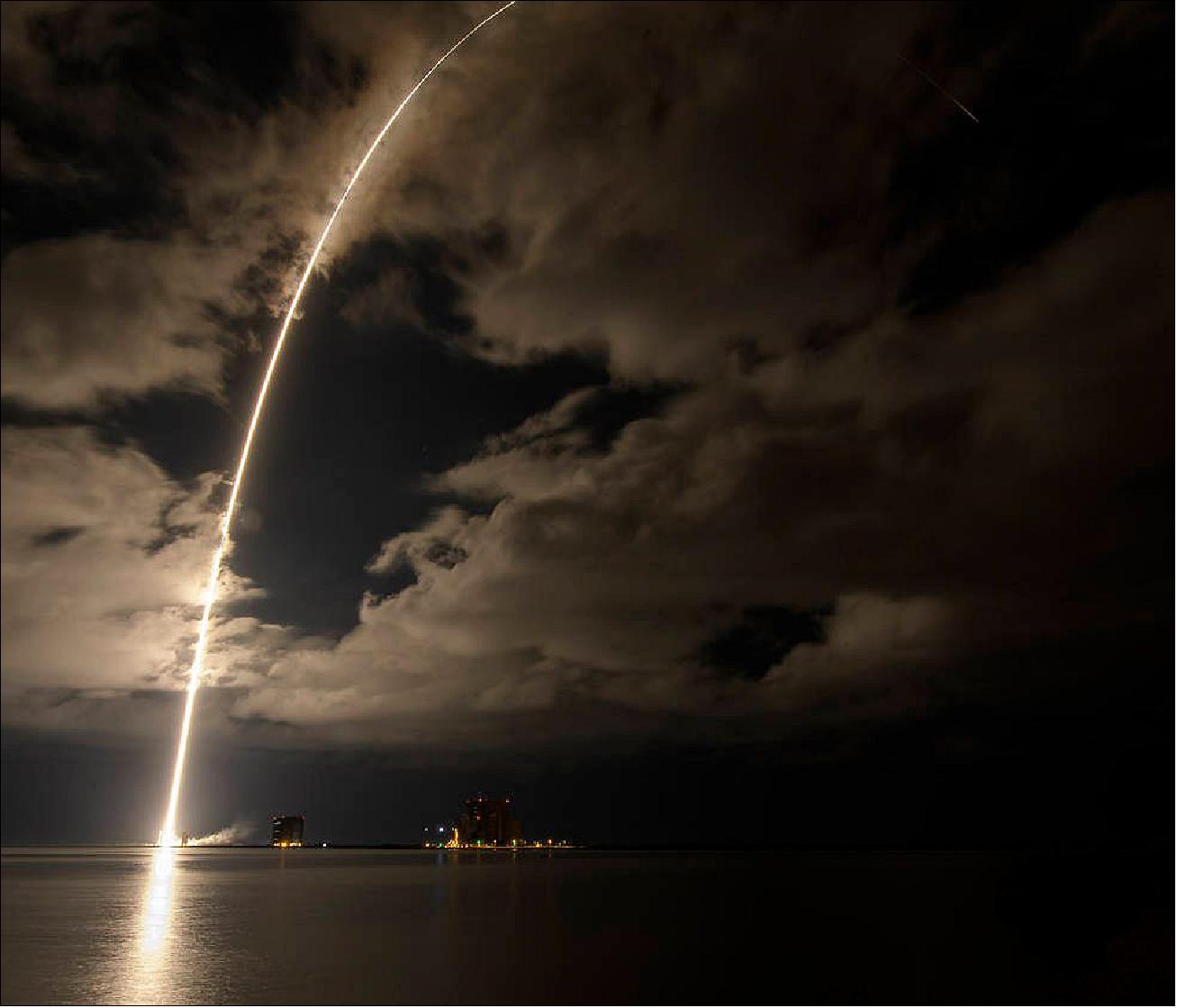
- Over the next 12 years, Lucy will fly by one main-belt asteroid and seven Trojan asteroids, making it the agency's first single spacecraft mission in history to explore so many different asteroids. Lucy will investigate these "fossils" of planetary formation up close during its journey.
- "Lucy embodies NASA's enduring quest to push out into the cosmos for the sake of exploration and science, to better understand the universe and our place within it," said NASA Administrator Bill Nelson. "I can't wait to see what mysteries the mission uncovers!"
- About an hour after launch, Lucy separated from the second stage of the ULA Atlas V 401 rocket. Its two massive solar arrays, each nearly 7.3 m wide, successfully unfurled about 30 minutes later and began charging the spacecraft's batteries to power its subsystems.
- "Today's launch marks a genuine full-circle moment for me as Lucy was the first mission I approved in 2017, just a few months after joining NASA," said Thomas Zurbuchen, associate administrator for the Science Mission Directorate at the agency's Headquarters in Washington. "A true mission of discovery, Lucy is rich with opportunity to learn more about these mysterious Trojan asteroids and better understand the formation and evolution of the early solar system."
- Lucy sent its first signal to Earth from its own antenna to NASA's Deep Space Network at 6:40 a.m. The spacecraft is now traveling at roughly 67,000 mph (108,000 km/h) on a trajectory that will orbit the Sun and bring it back toward Earth in October 2022 for a gravity assist.
- Named for the fossilized skeleton of one of our earliest known hominin ancestors, the Lucy mission will allow scientists to explore two swarms of Trojan asteroids that share an orbit around the Sun with Jupiter. Scientific evidence indicates that Trojan asteroids are remnants of the material that formed giant planets. Studying them can reveal previously unknown information about their formation and our solar system's evolution in the same way the fossilized skeleton of Lucy revolutionized our understanding of human evolution.
- "We started working on the Lucy mission concept early in 2014, so this launch has been long in the making," said Hal Levison, Lucy principal investigator, based out of the Boulder, Colorado, branch of Southwest Research Institute (SwRI), which is headquartered in San Antonio. "It will still be several years before we get to the first Trojan asteroid, but these objects are worth the wait and all the effort because of their immense scientific value. They are like diamonds in the sky."
- Lucy's Trojan destinations are trapped near Jupiter's Lagrange points – gravitationally stable locations in space associated with a planet's orbit where smaller masses can be trapped. One swarm of Trojans is ahead of the gas giant planet, and another is behind it. The asteroids in Jupiter's Trojan swarms are as far away from Jupiter as they are from the Sun.
- The spacecraft's first Earth gravity assist in 2022 will accelerate and direct Lucy's trajectory beyond the orbit of Mars. The spacecraft will then swing back toward Earth for another gravity assist in 2024, which will propel Lucy toward the Donaldjohanson asteroid – located within the solar system's main asteroid belt – in 2025.
- Lucy will then journey toward its first Trojan asteroid encounter in the swarm ahead of Jupiter for a 2027 arrival. After completing its first four targeted flybys, the spacecraft will travel back to Earth for a third gravity boost in 2031, which will catapult it to the trailing swarm of Trojans for a 2033 encounter.
- "Today we celebrate this incredible milestone and look forward to the new discoveries that Lucy will uncover," said Donya Douglas-Bradshaw, Lucy project manager at NASA's Goddard Space Flight Center in Greenbelt, Maryland.
- NASA Goddard provides overall mission management, systems engineering, plus safety and mission assurance. Lockheed Martin Space in Littleton, Colorado, built the spacecraft. Lucy is the 13th mission in NASA's Discovery Program. NASA's Marshall Space Flight Center in Huntsville, Alabama, manages the Discovery Program for the agency.
Orbit
• January 31, 2019: NASA has selected United Launch Services LLC (ULS) of Centennial, Colorado, to provide launch services for the agency's first-ever mission to explore Trojan asteroids. The launch is on an Atlas V 401 rocket from Launch Complex 41 at Cape Canaveral Air Force Station in Florida. With boosts from Earth's gravity, the spacecraft will embark on a 12-year journey to study primitive asteroids orbiting the Sun in tandem with Jupiter. 20)
In 2025 it will fly by the inner main-belt asteroid 52246 Donaldjohanson, which was named for the discoverer of the Lucy hominin fossil. In 2027 it will arrive at the L4 Trojan cloud (a group of asteroids that orbits about 60° ahead of Jupiter), where it will fly by four Trojans, 3548 Eurybates, 15094 Polymele, 11351 Leucus, and 21900 Orus. After these flybys, Lucy will return to the vicinity of the Earth whereupon it will receive a gravity assist to take it to the L5 Trojan cloud (which trails about 60° behind Jupiter), where it will visit the binary Trojan 617 Patroclus with its satellite Menoetius in 2033.
Date | Target | Group | Diameter | Type |
20 April 2025 | 52246 | Inner main belt, | 4 km | C-type asteroid. Lucy will flyby the asteroid from 922 km |
12 August 2027 | 3548 Eurybates | Greek camp at L4 | 64 km | C-type asteroid, largest member of the only confirmed disruptive |
15 September 2027 | 15094 Polymele | Greek camp at L4 | 21 km | P-type asteroid that may be a collisional fragment of a larger P-type |
18 April 2028 | 11351 Leucus | Greek camp at L4 | 34 km | D-type asteroid, slow rotator taking 466 hours per rotation. |
11 November 2028 | 21900 Orus | Greek camp at L4 | 51 km | Characterized as a D-type and C-type asteroid by the Lucy mission |
2 March 2033 | 617 Patroclus | Trojan camp at L5 | Patroclus: | They are binary P-type asteroids. The pair orbit at a separation |
Mission Status
• June 10, 2022: Leaders of NASA's Lucy asteroid mission are increasingly confident that the mission can continue as planned even if ongoing efforts to fully deploy and latch a solar array don't succeed. 22)
- Engineers have been studying for months one of two circular solar arrays that did not fully deploy and latch into place after the spacecraft's launch in October 2021. They concluded that a lanyard used to pull open the solar array lost tension during the deployment process, causing the lanyard to wrap around the motor shaft.
- On May 9, controllers issued commands to run both the primary and backup motors for the solar array deployment process simultaneously, hoping that a harder pull would be sufficient to restore tension in the lanyard and continue deployment of the array. The spacecraft similarly ran both motors three times since then.
- "That's allowing us to make significant process towards latch, but we're not latched yet," Hal Levison, principal investigator for Lucy at the Southwest Research Institute, said in a presentation at a meeting of NASA's Small Bodies Assessment Group June 8. "We are seeing significant tensioning of the array."
- That tensioning, he said, is a positive sign even though the array has not latched into place. "It makes it likely that, even if we don't get the thing latched, we'll be able to fly the mission as-is," he said, noting the array, in its current configuration, is generating more than 90% of its planned power.
- The mission is preparing for an Earth gravity-assist flyby in October, when the spacecraft will pass about 350 km above the Earth. After a second Earth flyby in 2024, Lucy will go past an asteroid in the main belt in 2025, then several Trojan asteroids in a cluster leading Jupiter in orbit around the sun in 2027 and 2028. A third Earth flyby in 2030 will set up encounters with two Trojan asteroids in a separate cluster trailing Jupiter in 2033.
- To set up the October flyby, Lucy performed a trajectory correction maneuver June 7, NASA said in a June 8 blog post. The maneuver is the first of several planned before the October flyby.
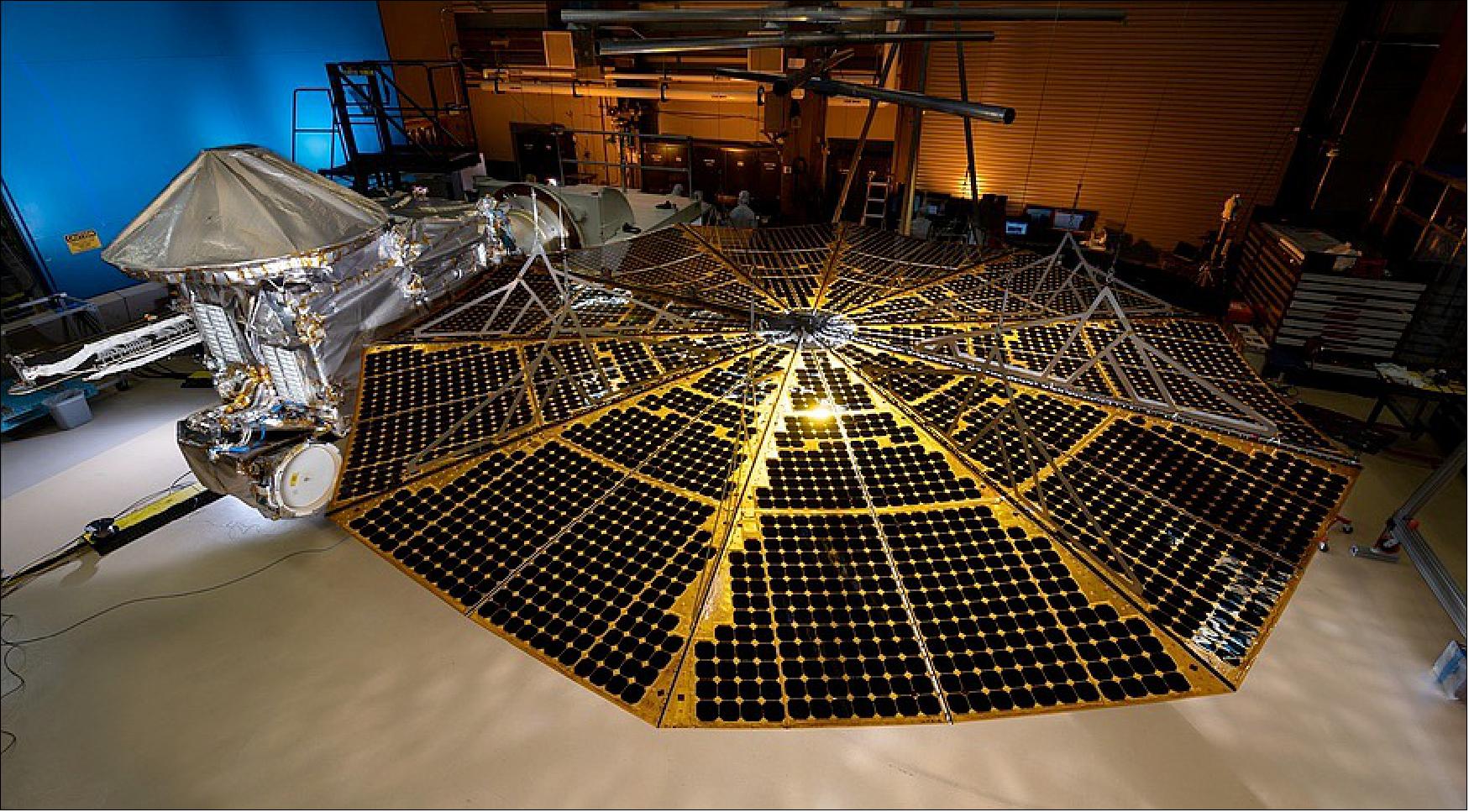
• April 11, 2022: On Feb. 14, NASA's Lucy spacecraft, which is in the first few months of its journey to the Trojan asteroids, obtained a series of calibration images with its four visible-light cameras. The first test images were taken in November 2021, shortly after Lucy's Oct. 16, 2021, launch, but the February test was much more extensive. Lucy used its Instrument Pointing Platform to point at 11 different star fields to test camera performance and sensitivity, as well as the spacecraft's ability to point accurately in different directions. 23)
- The four cameras are the twin Terminal Tracking Cameras (T2CAM), the Multicolor Visible Imaging Camera (MVIC), and the Long-Range Reconnaissance Imager (L'LORRI). The T2CAM cameras have a wide field of view, 11 degrees by 8.2 degrees, and are primarily used to automatically lock onto and track the Trojan asteroids during Lucy's close flybys, ensuring that the spacecraft's other instruments are pointed at the target. MVIC, part of the L'Ralph instrument, is a higher-resolution color scanning camera that can scan its 8.3-degree-tall field of view across as wide a swath as desired, much like the panoramas taken by a mobile phone camera. L'LORRI is a high-resolution monochromatic telephoto camera with a narrow 0.29-degree-square field of view and will obtain Lucy's most detailed images of its asteroid targets.
- The test did not include Lucy's infrared spectrometer LEISA (also part of the L'Ralph instrument) or its temperature mapping L'TES instrument, which requires close-up planetary targets to obtain useful data.
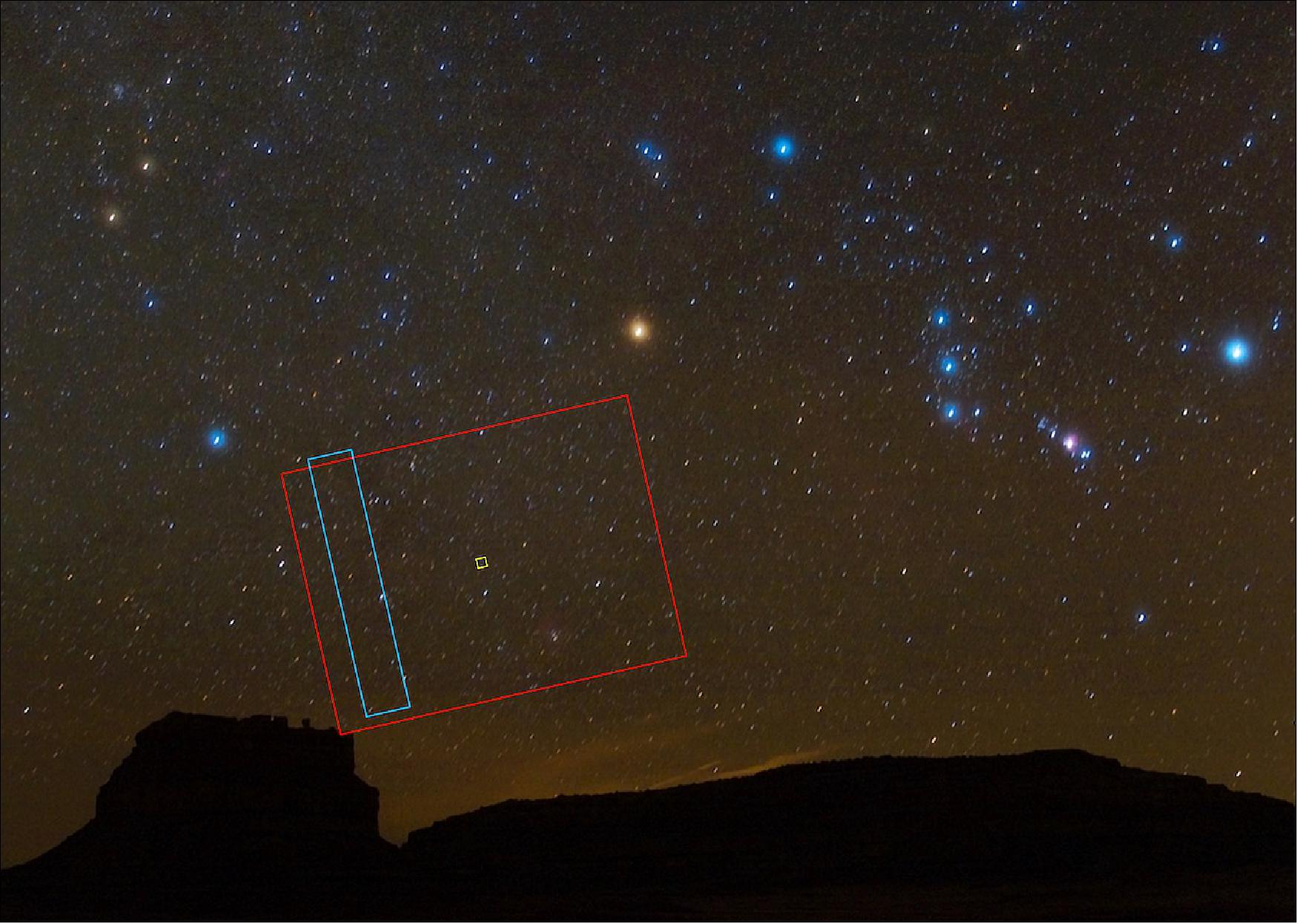
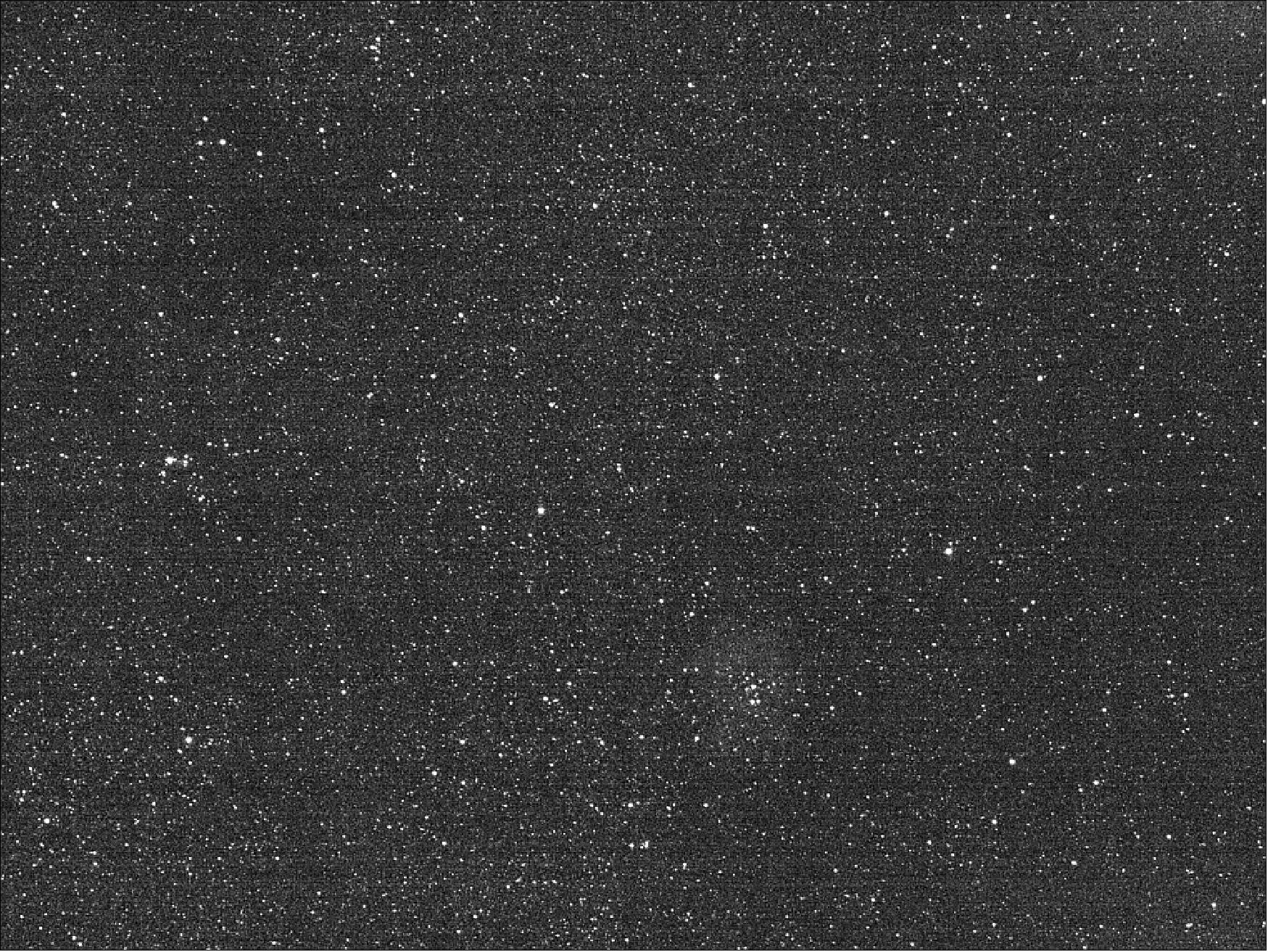

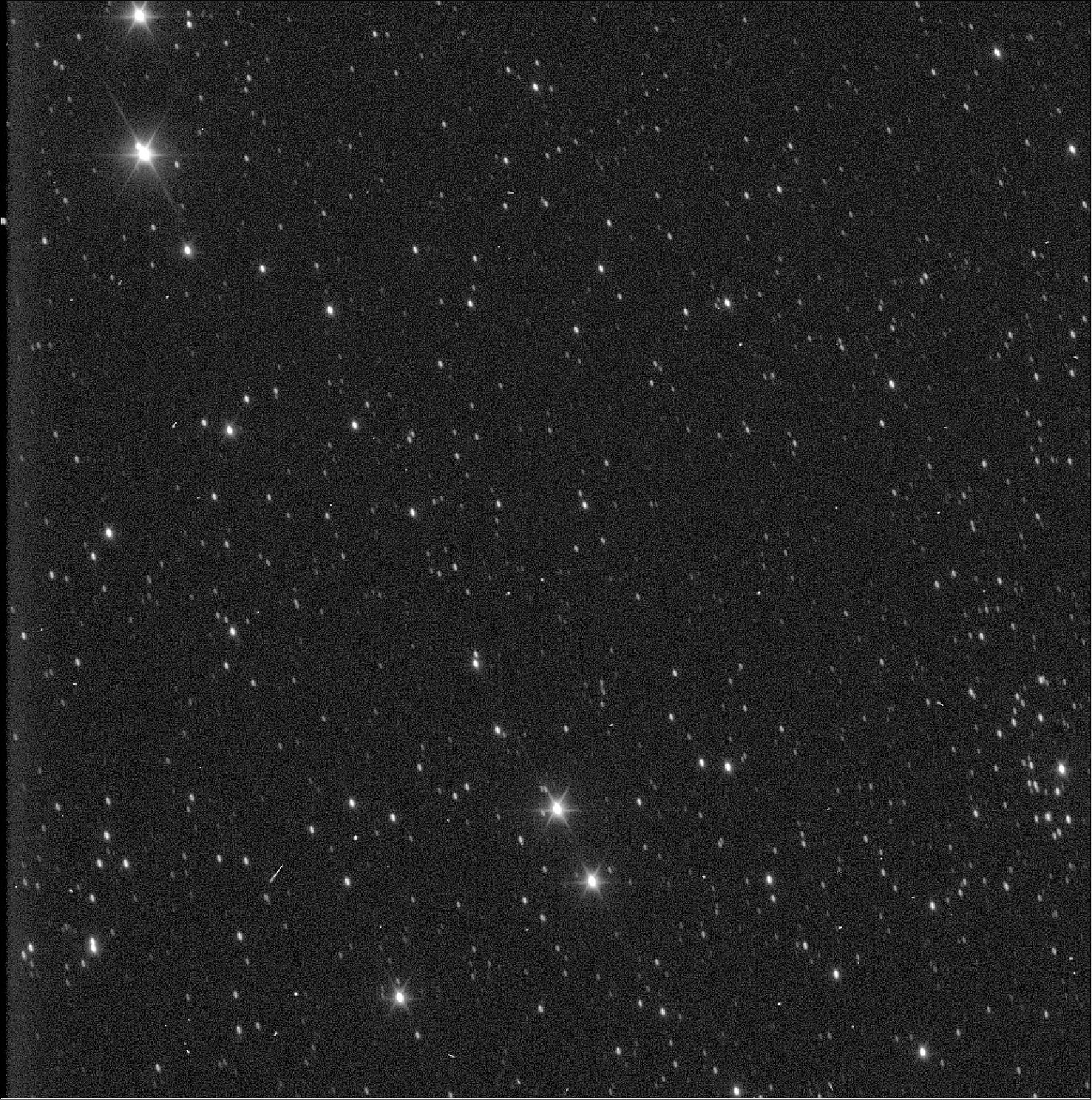
• January 25, 2021: Engineers have identified the likely reason one of two solar arrays on NASA's Lucy asteroid mission failed to latch in place after launch, but NASA is still studying whether to fix the problem. 24)
- At a Jan. 25 meeting NASA's Small Bodies Assessment Group, Hal Levison, principal investigator for Lucy at the Southwest Research Institute, expressed confidence that, regardless if the solar array is fully deployed or not, the issue will not affect the spacecraft's ability to carry out its mission to study several Trojan asteroids leading and following Jupiter in its orbit around the sun.
- Shortly after its Oct. 16 launch, deployed two large circular solar arrays, each 7.3 meters in diameter. The arrays are designed to unfurl like fans and latch into place. While one array, called -Y, did completely unfurl and latch, the other, +Y, did not latch into place.
- "People have been working day and night since the launch to try and figure out what's going on, and I think we understand it," Levison said. The +Y array, rather than unfurling a full 360 degrees, instead went 347 degrees. In that configuration, the spacecraft is still generating more than 90% of its expected power. "Power is not an issue for the spacecraft, nor will it be through the entire mission if we have to fly it like it is."
- The arrays unfurl when a motor pulls on a lanyard, swinging one end of the array around and into place. Levison said that the most likely reason the array did not latch is that, for some reason, there was a loss of tension in the lanyard during deployment. That caused it to fall off a spool and wrap around the motor shaft. About 75 centimeters of lanyard remains to be pulled in.
- "It matches the data really well, so we have really high confidence this is true," he said. One possible cause of the loss of tension, he added, is a "dynamic interaction" between the two arrays during the deployment.
- Mission managers are considering two alternatives. One is to turn the motors back on and try to bring in the remaining lanyard segment so that the array can lock into place. "We're almost there, so I think if we can pull a little harder, we might be able to get it to latch," he said. The motor can pull harder, he said, but engineers want to assess the risks of doing so before making another attempt.
- The other option is to keep the array as is. While the array can generate enough power without being fully deployed, Levison said engineers want to study its integrity in that configuration during main engine burns. "The analysis so far is looking good. We should be able to do at least some of the main engine burns we're planning."
- There's no rush to decide whether to redeploy the array or leave it as is. "We have plenty of time because we're not scheduled to fire the main engine for a while," he said. "We're taking our time to carefully go through our options."
- That assessment matches the most recent NASA update about the mission, published Jan. 12. It stated that the current plan for the mission "supports a latch attempt in the late April timeframe" but that engineers were still studying leaving the array in its current unlatched condition.
- Levison added that all other aspects of the spacecraft, including its instruments, were working well. "Except for this problem, the spacecraft is really kicking butt," he said. "The instruments and the spacecraft are all behaving nominally."
• January 12, 2022: The Lucy spacecraft, launched on Oct. 16, 2021, is now over 30 million miles (48 million km) from Earth and continues to operate safely in "outbound cruise" mode. Besides a solar array that didn't latch after deployment — an issue the mission team is working to resolve— all spacecraft systems are normal. The arrays are producing ample energy, charging the spacecraft's battery as expected under normal operating conditions. 25)
- The current plan supports a latch attempt in the late April timeframe; however, the team is continuing to study the possibility of leaving the array as is. In the meantime, in the lab, they are testing a dual motor solar array deployment using both the primary and backup motor. The testing aims to determine if engaging both motors at the same time applies enough force to complete the deployment and latch the solar array.
- In addition to the solar array activity, the team continues to run routine operations on the spacecraft. The next activity is calibrating guidance, navigation & control hardware to ensure pointing accuracy of the spacecraft.
- On January 5, Lucy completed a test to look at the dynamics of the spacecraft in order to characterize the solar array.
• December 16, 2021: Gathering near Las Vegas recently, dozens of astronomers spread throughout the region, pointed their telescopes at the sky and waited for the moment on Oct. 20 that the light from a faraway star blinked out. 26)
- It was an event so miniscule it would have been easy to miss. Yet the data gathered in those few seconds will contribute to the success of NASA's Lucy mission, which launched from Cape Canaveral Space Force Station in Florida on Oct. 16.
- The star appeared to briefly blink out because the asteroid Eurybates had passed in front of it. Eurybates is one of a handful of asteroids Lucy will visit over the next 12 years.
- As Eurybates eclipsed the star, a phenomenon scientists call an "occultation," a 40-mile- (64-kilometer-) wide shadow the size of the asteroid passed over the region. By spreading out inside the shadow's predicted path across Nevada, astronomers sought to measure the width of Eurybates down to several hundred feet, or a couple hundred meters, and to ascertain its shape. This information will be used by Lucy researchers to supplement data gathered by the Lucy spacecraft's close flyby of Eurybates in 2027, which is designed to determine what the asteroid is made of and where in the solar system it formed billions of years ago.
Why Occultations?
- An occultation is any event where one celestial object passes in front of another, blocking the latter object from an observer's view. The best-known example is a solar eclipse, which occurs when the Moon passes between the Sun and Earth, blocking the Sun from our view.
- "It really does look like a star just vanished," said Marc Buie, occultation science lead for the Lucy mission at the Southwest Research Institute, which is headquartered in San Antonio. Buie helped coordinate the Eurybates observations in Nevada. "It's kind of a weird thing to see, but an occultation gives us really valuable information."
- Observing occultations is one of the tools scientists have for gathering precise information about the size and shape of Lucy's target destinations, known as "Trojan" asteroids. These Trojans are clustered in two swarms that orbit the Sun at about the same distance as Jupiter (though they're as far away from Jupiter as they are from the Sun). Trojan asteroids are remnants of the early solar system, with the largest ones named after characters from Greek mythology. The Lucy mission, for the first time, will analyze seven of them up close, helping scientists hone the theory of how the planets formed and ended up in their current locations.
- While scientists can spot Trojan asteroids using powerful observatories such as NASA's Hubble Space Telescope (and in fact discovered a moon of Eurybates this way in 2018), the asteroids appear only as small points of light, so it's challenging to precisely determine their true sizes and shapes.
- "Occultations are one way for us to learn as much as we can about the objects before Lucy gets there, so that we can make the most of the brief opportunity we'll get when the spacecraft is super close to each target," said Brian Keeney, an occultation specialist for the Lucy mission at the Southwest Research Institute.
- After Lucy reaches each asteroid, scientists will be able to measure each asteroid's mass. That information, combined with size and shape data from flybys, occultations, and other Earth-based techniques, will help reveal the density of each asteroid. Density tells scientists about composition, or whether an asteroid is made mostly of ice or of rock. Scientists hope to compare the compositions of the Trojan asteroids to figure out if they came from the same or different parts of the solar system about 4.5 billion years ago, and how the Trojans relate to other asteroids in the solar system.
- "Lucy will see each asteroid's surface, but we need to learn more about the interior, which is where occultations can help," Keeney said.
Watching a Star Disappear
- To prepare for an occultation, astronomers predict a shadow's path across Earth, based on the known orbit of the asteroid and the precise position of the star to be occulted. Then they set up dozens of telescopes along a line perpendicular to that path and wait for the asteroid to eclipse a specific star. They count the seconds that starlight blinks out as the asteroid passes in front of it and then use the asteroid's known velocity to calculate its width.
- Since the occultation time, and thus width, is different at each point on the line where telescopes are stationed — with each telescope station corresponding to a different line across the asteroid — scientists can also determine the shape of an asteroid's silhouette by combining data from each telescope. By observing multiple occultations of the same asteroid, scientists can catch different sides of the asteroid and combine their two-dimensional silhouette projections into a three-dimensional shape model.
- "Occultations have proven to be an excellent technique to maximize the science return of missions such as Lucy," said Adriana Ocampo, program executive for the Lucy mission based at NASA Headquarters in Washington.
- Accurate predictions of future occultation times and locations rely on impeccable information related to star and asteroid locations. When Buie started tracking occultations in the 1980s, the data available left him with huge areas of uncertainty, meaning his team could end up miles outside an asteroid's shadow. To catch an occultation of a 10-mile- (20-kilometer-) wide asteroid, for instance, Buie would have spread telescopes out along a 190-mile (300-kilometer) path. Today, that area is six times smaller.
- Astronomers' predictions have improved dramatically thanks to Hubble and ESA's (the European Space Agency) Gaia satellite, which help pin down the precise locations of nearly 2 billion stars. Additionally, the trajectories of Lucy's fast-moving target asteroids are constantly monitored and refined using ground-based telescopes and occasionally Hubble.
How to Catch an Occultation
- Buie calls occultation events "mega campaigns," as they require large teams, precise location predictions for each telescope, and many telescopes for successful data collection. In Nevada, for instance, professional and amateur astronomers from across the country, including teachers and high school students, used 37 telescopes to observe Eurybates.
- But occultations happen all over world, from Argentina to South Africa, Senegal and Spain. Buie and other Lucy scientists must coordinate travel to these destinations, find observation volunteers locally, and train them.
- "Occultations provide an important international collaborative factor of scientific advancement for the good of humanity, excitement, engagement and inspiration which is at the core of NASA's mission," said Ocampo, who participates in observation campaigns.
- On top of the logistical challenges of organizing occultation campaigns, scientists must contend with unpredictable weather. Successful campaigns depend on clear skies. As observers waited for Eurybates occultation in Nevada, they saw clouds moving toward them.
- "If that Eurybates occultation had been an hour later, nobody would've seen anything," Buie said. "The clouds would have wiped us out."
- The team will continue to observe occultations until Lucy's last flyby of Trojan asteroid Patroclus in 2033, even in the face of bad weather.
- To learn about how Lucy's complex and unique trajectory was designed and the big solar system questions the mission will help answer, check out: NASA's Lucy Mission: A Journey to the Young Solar System.
• October 17, 2021: Engineers are investigating why one of the two solar arrays on NASA's Lucy spacecraft may have failed to lock into place when deployed after launch Oct. 16. 27)
- In an Oct. 17 statement, NASA said that while the spacecraft is healthy, one of the two circular solar panels "may not be fully latched" after its deployment. The solar arrays deployed in the first half-hour after separation from the Centaur upper stage of the Atlas 5 rocket that launched it early Oct. 16.
- Both solar panels are generating power, the agency stated, and there are no other problems with the spacecraft. "In the current spacecraft attitude, Lucy can continue to operate with no threat to its health and safety," NASA said in the statement. "The team is analyzing spacecraft data to understand the situation and determine next steps to achieve full deployment of the solar array."
- "This team has overcome many challenges already and I am confident they will prevail here as well," Thomas Zurbuchen, NASA associate administrator for science, tweeted Oct. 17.
- Lucy's two solar panels are each 7.3 meters in diameter. Stored in a folded configuration, they were designed to unfurl "like Chinese fans," said Joan Salute, associate director for flight programs in NASA's planetary science division, at a prelaunch briefing Oct. 14.
- The arrays have a combined 51 square meters of solar cells. That large area is needed since the spacecraft will be flying out to Jupiter's distance from the sun, where the sunlight is only a few percent as powerful as at Earth. "That enables Lucy to travel further away from the sun than any other solar-powered spacecraft to date," said Katie Oakman, Lucy structures and mechanisms lead at Lockheed Martin Space, at the Oct. 14 briefing. Lockheed was the prime contractor for Lucy, although the solar arrays were built by Northrop Grumman.
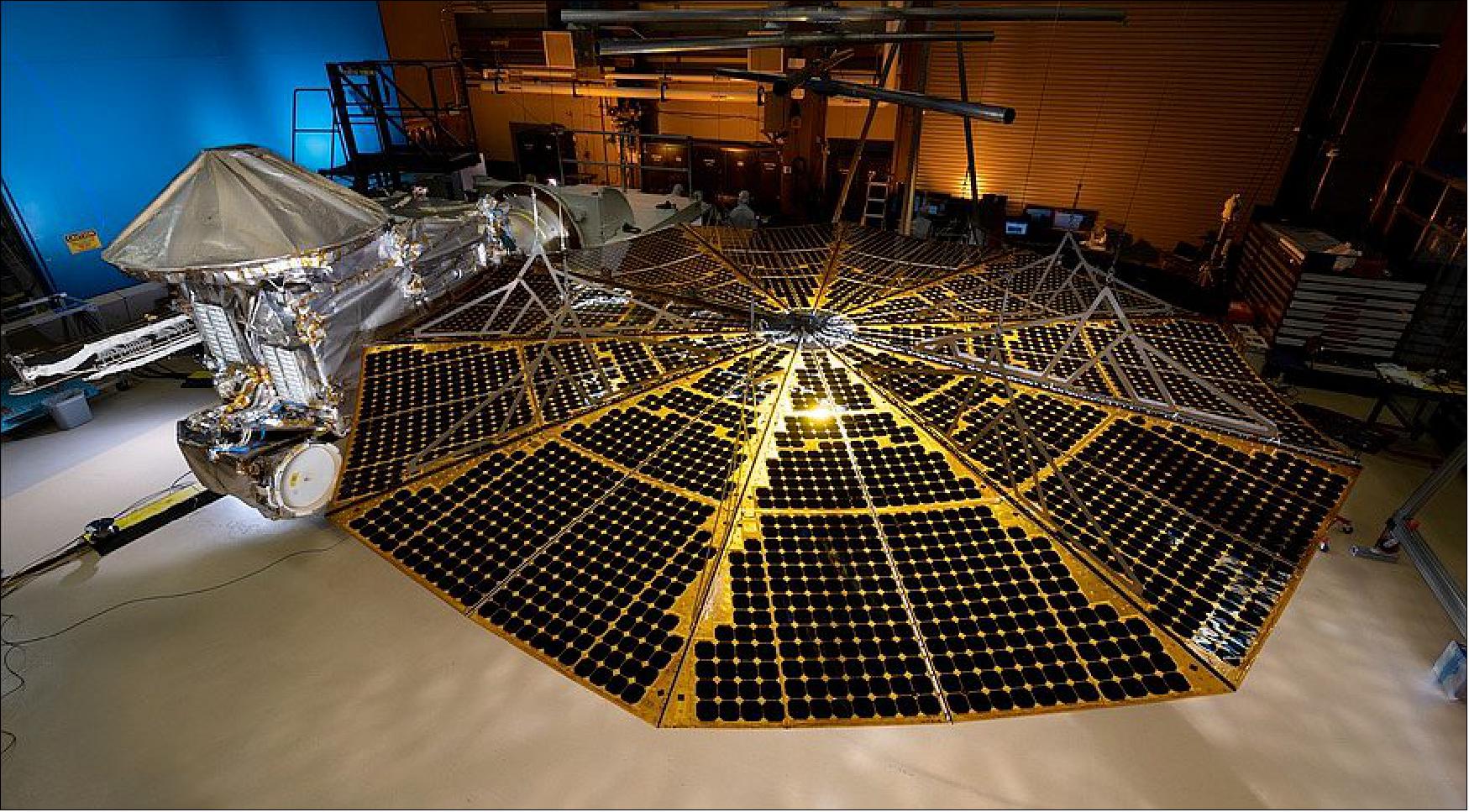
- In the vicinity of the Earth, Lucy's panels can generate 18 kW of power. However, when flying by the Trojan asteroids that are the destination of the mission, the arrays will produce only 500 watts of power, still sufficient to operate the spacecraft and its three main instruments.
- She added there was no specific design requirement for circular arrays versus more conventional rectangular ones, but that those offered the most area while fitting in the confines of the Atlas payload fairing. "This particular design really enables us to stow up closely and tightly next to the spacecraft for launch," she said. "Having any particular shape other than this really unique design wouldn't enable us to get to that 51-meter-squared of active cell area and still fit within the launch vehicle fairing."
- It's unclear if the problem will affect other work to check out the spacecraft after its launch. That includes deployment of the instrument pointing platform, on which the three major instruments are mounted, which is scheduled for about two days after launch.
Sensor complement
Lucy's instrument platform (IPP) will carry four instruments for remote-sensing science. — Lucy carries updated versions of proven instruments from spacecraft like New Horizons, OSIRIS-REx and Mars Global Surveyor to study the geology, surface composition and physical properties of Jupiter's Trojan asteroids
L' Ralph
L'Ralph is Lucy's color visible imager (the Multi-spectral Visible Imaging Camera, MVIC, 0.4-0.85 µm) and infrared imaging spectrometer (Linear Etalon Imaging Spectral Array, LEISA, 1-3.6 µm). LEISA will allow us to look for the absorption lines that serve as the fingerprints for different silicates, ices and organics that likely will be on the surface of the Trojan asteroids. MVIC will take color images of the Trojan asteroid targets, and help determine how active they are.
L' LORRI (Long Range Reconnaissance Imager)
L' LORRI is the high spatial resolution visible imager. It is panchromatic, covering the wavelengths 0.35-0.85 µm. This camera will provide the most detailed images of the surface of the Trojans.
L' TES (Thermal Emission Spectrometer)
L' TES is similar to instruments flying on OSIRIS-REx and Mars Global Surveyor. This infrared spectrometer (6-75 µm) will allow the Lucy team to learn much more about the properties of the Trojans such as their thermal inertia, how well the bodies retain heat, which teaches us about the composition and structure of material on the surface of the asteroids.
January 2021: NASA's Lucy mission is one step closer to launch as L'TES, the Lucy Thermal Emission Spectrometer, has been successfully integrated on to the spacecraft. 28)
"Having two of the three instruments integrated onto the spacecraft is an exciting milestone," said Donya Douglas-Bradshaw, Lucy project manager from NASA's Goddard Space Flight Center in Greenbelt, Maryland. "The L'TES team is to be commended for their true dedication and determination."
Lucy will be the first space mission to study the Trojan asteroids, leftover building blocks of the Solar System's outer planets orbiting the Sun at the distance of Jupiter. The mission takes its name from the fossilized human ancestor (called "Lucy" by her discoverers) whose skeleton provided unique insight into humanity's evolution. Likewise, the Lucy mission will revolutionize our knowledge of planetary origins and the birth of our solar system more than 4 billion years ago.
L'TES, developed by a team at Arizona State University (ASU), is effectively a remote thermometer. It will measure the far infrared energy emitted by the Trojan asteroids as the Lucy spacecraft flies by an unprecedented seven of these objects during this first ever mission to this population.
The instrument arrived at Lockheed Martin Space on December 13 and was successfully integrated on to the spacecraft on December 16. By measuring the Trojan asteroids' temperatures, L'TES will provide the team with important information on the material properties of the surfaces. As the spacecraft will not be able to touch down on the asteroids during these high speed encounters, this instrument will allow the team to infer whether the surface material is loose, like sand, or consolidated, like rocks. In addition, L'TES will collect spectral information using thermal infrared observations in the wavelength range from 4 to 50 µm.
"The L'TES team has used our experienced designing, manufacturing, and operating similar thermal emission spectrometers on other missions such as OSIRIS-REx and the Mars Global Surveyor as we built this instrument," said Instrument Principal Investigator, Phil Christensen. "Each instrument has its own challenges, but based on our experience we expect L'TES to give us excellent data, as well as likely some surprises, about these enigmatic objects."
Despite the challenges surrounding the COVID-19 pandemics, Lucy is on schedule to launch in October 2021 as originally planned.
"I am constantly impressed by the agility and flexibility of this team to handle any challenges set before them," said mission Principal Investigator, Hal Levison of Southwest Research Institute. "Just five years ago this mission was an idea on paper, and now we have many major components of the spacecraft and payload assembled, tested, and ready to go."
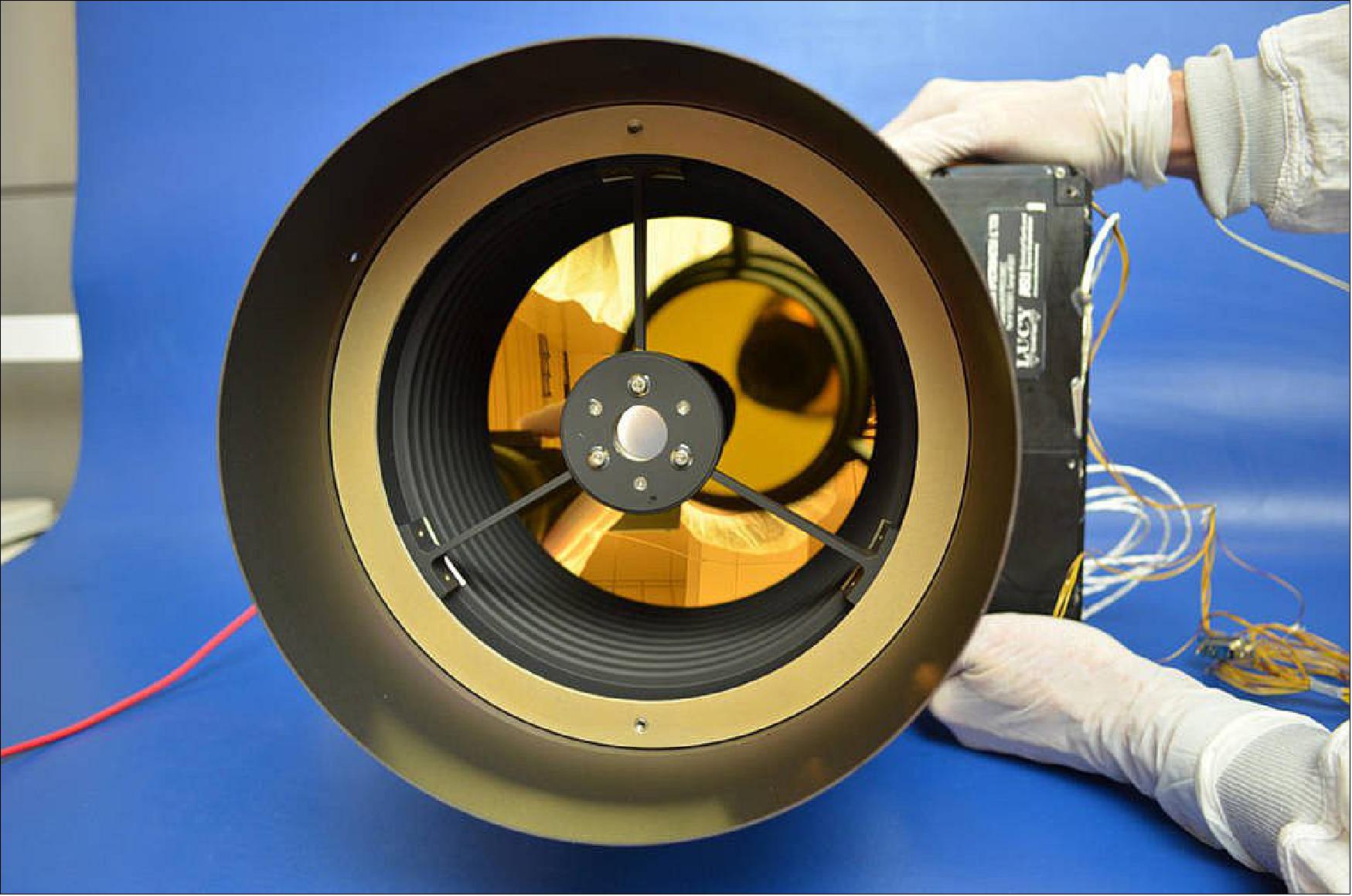
T2CAM (Terminal Tracking Camera)
Additionally, Lucy will be able to use its High Gain Antenna to determine the masses of the targets using the Doppler shift of the radio signal. Lucy will be able to use its T2CAM to take wide-field images of the asteroids to better constrain the asteroids shapes.
References
1) "Lucy: The First Mission to Jupiter's Trojans," NASA, 29 January 2019, URL: https://www.nasa.gov/content/goddard/lucy-the-first-mission-to-jupiter-s-trojans2) "Lucy -Surveying the Diversity of the Trojan Asteroids," SwRI, URL: http://lucy.swri.edu/
3) Nancy Neal Jones, "NASA Selects Mission to Study Jupiter's Trojan Asteroids," NASA, 4 January 2017, URL: https://www.nasa.gov/feature/goddard/2017/nasa-selects-mission-to-study-jupiter-s-trojan-asteroids
4) Nancy Neal Jones, Katherine Kretke, Karl Hille, "The Lucy Spacecraft and Payload," SwRI, 9 July 2018, URL: http://lucy.swri.edu//mission/Spacecraft.html
5) Anna Blaustein, Lina Tran, "How the Sun Affects Asteroids in Our Neighborhood," NASA Feature, 15 October 2021, URL: https://www.nasa.gov/feature/goddard/2021/how-sun-affects-asteroids-in-our-neighborhood-lucy-heliosphere
6) "Exploring the Solar System: Lucy Goes to Space," NASA/GSFC, 15 September 2021, URL: https://www.youtube.com/watch?v=ul5K74CladU
7) "NASA's Lucy Spacecraft Begins Launch Preparations," PR Newswire, 2 August 2021, URL: https://www.prnewswire.com/news-releases/nasas-lucy-spacecraft-begins-launch-preparations-301346238.html
8) Katherine Kretke, "NASA Lucy Mission's Message to the Future," NASA Feature, 12 July 2021, URL: https://www.nasa.gov/feature/goddard/2021/nasa-lucy-mission-s-message-to-the-future
9) "NASA's Lucy in the Cleanroom," NASA Feature, 1 June 2021, URL: https://www.nasa.gov/feature/goddard/2021/nasa-s-lucy-in-the-cleanroom
10) https://www.youtube.com/watch?v=6vjK9vGEw5Q
11) David Dezell Turner, "Hide and Seek – How NASA's Lucy Mission Team Discovered Eurybates' Satellite," NASA Feature, 19 April 2021, URL: https://www.nasa.gov/feature/goddard/2021/hide-and-seek-how-nasa-s-lucy-mission-team-discovered-eurybates-satellite
12) "NASA's First Mission to the Trojan Asteroids Installs its Final Scientific Instrument," NASA Feature, 9 February 2021, URL: https://www.nasa.gov/feature/goddard/2021/first-mission-to-trojans-installs-final-instrument
13) Nancy Jones, "NASA's Lucy Mission One Step Closer to Exploring the Trojan Asteroids," NASA, 28 August 2020, URL: https://www.nasa.gov/feature/goddard/2020/lucy-milestone-kdp-d
14) "NASA's Lucy Mission Passes Critical Mission Milestone," NASA Feature, 3 August 2020, URL: https://www.nasa.gov/feature/goddard/2020/lucy-mission-passes-critical-mission-milestone
15) "NASA's Lucy Mission Confirms Discovery of Eurybates Satellite," NASA Solar System and Beyond, 9 January 20220, URL: https://www.nasa.gov/feature/nasa-s-lucy-mission-confirms-discovery-of-eurybates-satellite
16) "NASA's Lucy Mission Clears Critical Milestone," NASA, 21 October 2019, URL: https://www.nasa.gov/feature/goddard/2019/lucy-mission-clears-critical-milestone
17) Stephen Clark, "ULA wins contract to launch NASA's Lucy mission to visit unexplored asteroids," Spaceflight Now, 1 February 2019, URL: https://spaceflightnow.com/2019/02/01/ula-wins-contract-to-launch-nasas-lucy-mission-to-visit-unexplored-asteroids/
18) "Lockheed Martin to Build NASA's Lucy Spacecraft, a Mission to Trojan Asteroids," Lockheed Martin, 5 January 2017, URL: https://news.lockheedmartin.com/2017-01-05-Lockheed-Martin-to-Build-NASAs-Lucy-Spacecraft-a-Mission-to-Trojan-Asteroids
19) Karen Fox, Alana Johnson, Nancy Neal Jones, "NASA, ULA Launch Lucy Mission to ‘Fossils' of Planet Formation," NASA Press Release 21-133, 16 October 2021, URL: https://www.nasa.gov/press-release/nasa-ula-launch-lucy-mission-to-fossils-of-planet-formation
20) "NASA Awards Launch Services Contract for Lucy Mission," NASA Contract Release C19-001, 31 January 2019, URL: https://www.nasa.gov/press-release/nasa-awards-launch-services-contract-for-lucy-mission
21) https://en.wikipedia.org/wiki/Lucy_(spacecraft)
22) Jeff Foust, "Efforts continue to fully deploy Lucy solar array," SpaceNews, 10 June 2022, URL:
23) John Spencer, "Checking in on the Cameras of NASA's Asteroids-Bound Lucy Spacecraft," NASA Feature, 11 April 2022, URL: https://www.nasa.gov/feature/goddard/2022/checking-in-on-the-cameras-of-nasa-s-asteroids-bound-lucy-spacecraft
24) Jeff Foust, "Cause of Lucy solar array deployment problem identified," SpaceNews, 25 January 2022, URL: https://spacenews.com/cause-of-lucy-solar-array-deployment-problem-identified/
25) Karen Fox, "Lucy Cruising Outbound; Testing Solar Array Options on Ground," NASA Lucy Mission, 12 January 2022, URL: https://blogs.nasa.gov/lucy/2022/01/12/lucy-cruising-to-orbit-testing-solar-array-options-on-ground/
26) Allison Gasparini, Lonnie Shekhtman, "Watching the Blink of a Star to Size Up Asteroids for NASA's Lucy Mission," NASA Feature, 16 December 2021, URL: https://www.nasa.gov/feature/goddard/2021/watching-the-blink-of-a-star-to-size-up-asteroids-for-nasa-s-lucy-mission
27) Jeff Foust, "NASA investigating issue with Lucy solar array," SpaceNews, 17 October 2021, URL: https://spacenews.com/nasa-investigating-issue-with-lucy-solar-array/
28) "NASA's First Mission to the Trojan Asteroids Integrates its Second Scientific Instrument," NASA Feature, 5 January 2021, URL: https://www.nasa.gov/feature/goddard/2021/first-mission-to-the-trojan-asteroids-integrates-its-second-scientific-instrument
The information compiled and edited in this article was provided by Herbert J. Kramer from his documentation of: "Observation of the Earth and Its Environment: Survey of Missions and Sensors" (Springer Verlag) as well as many other sources after the publication of the 4th edition in 2002. - Comments and corrections to this article are always welcome for further updates (herb.kramer@gmx.net).
Spacecraft Launch Mission Status Sensor Complement References Back to top